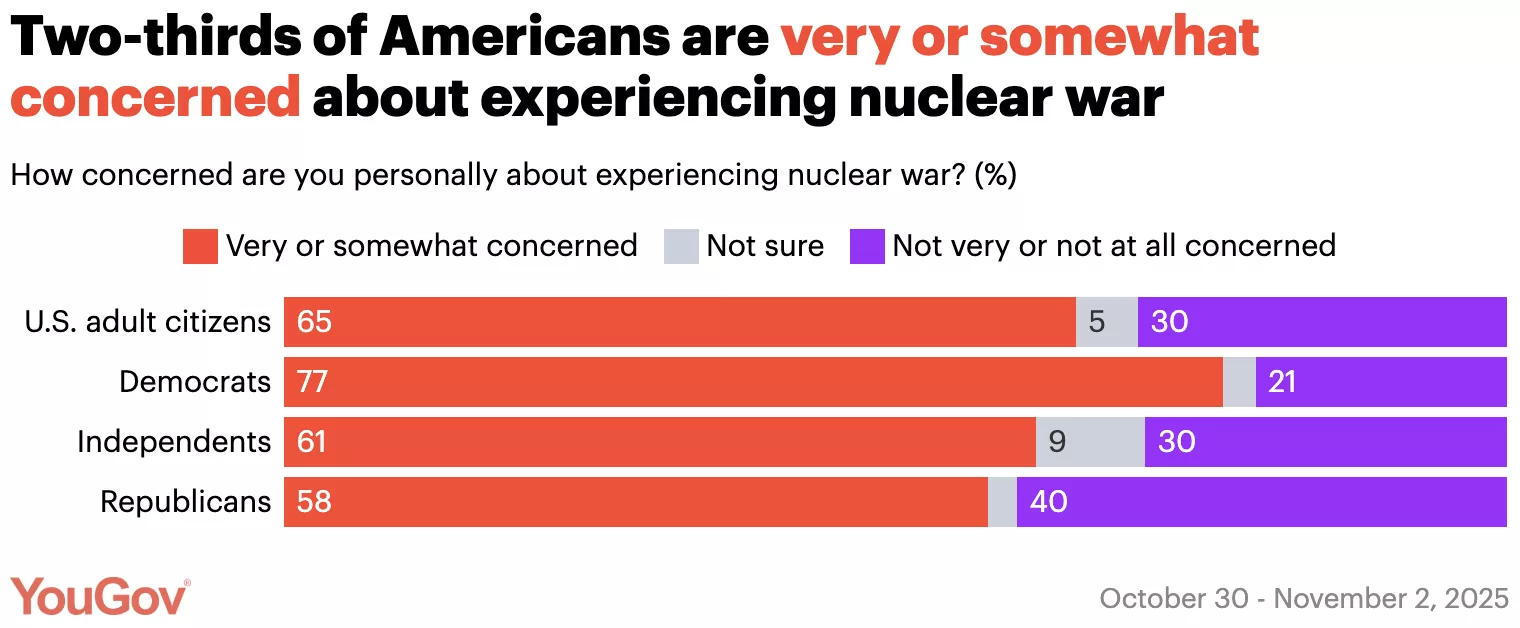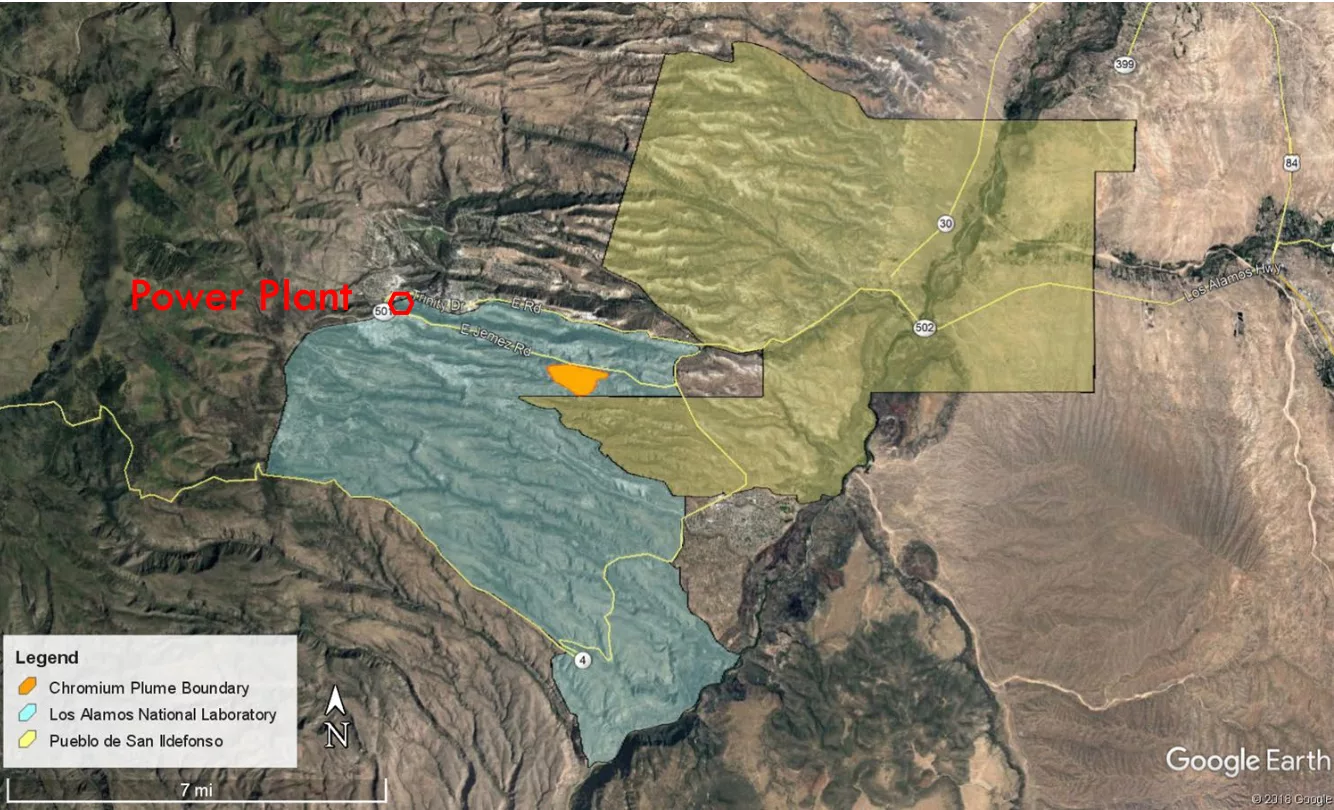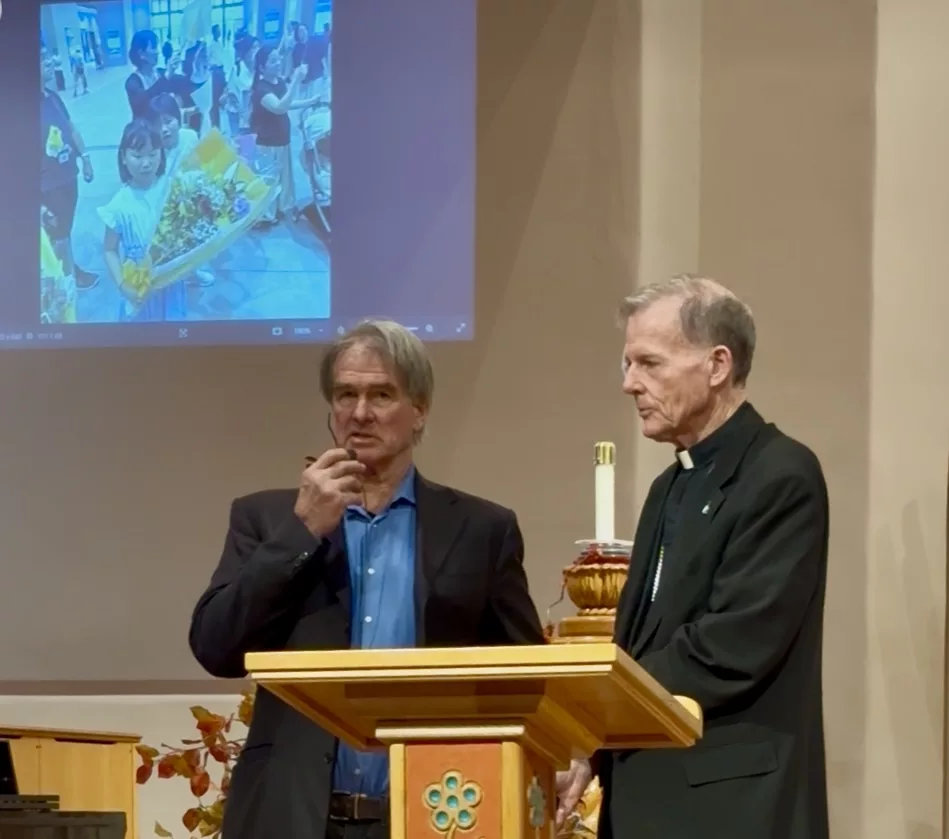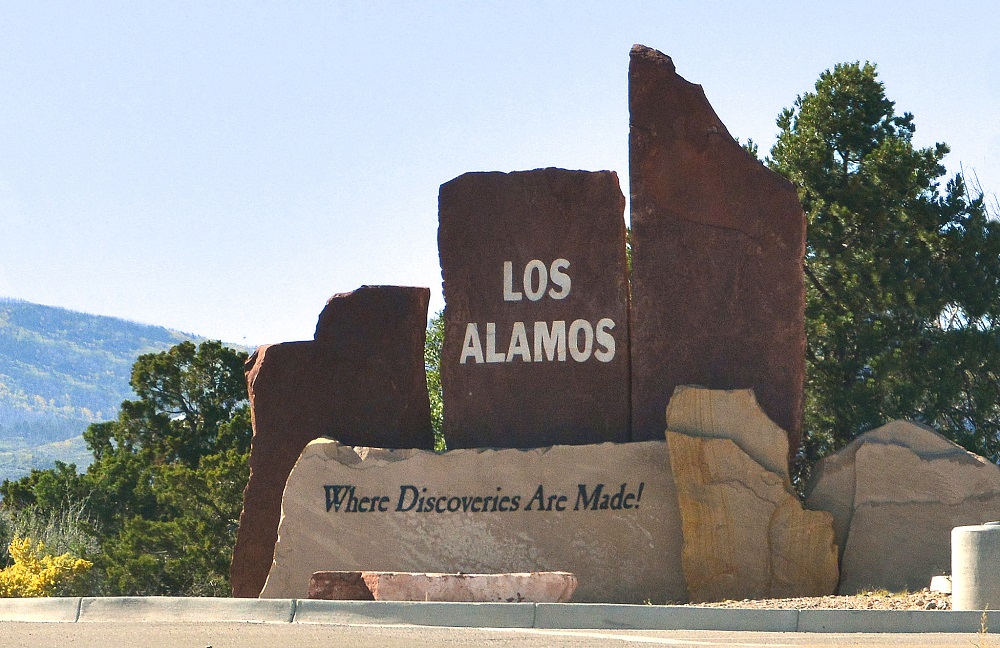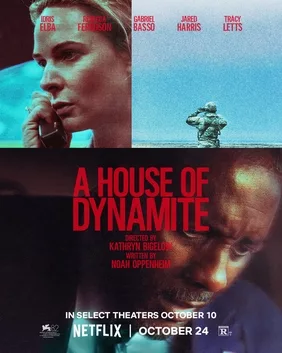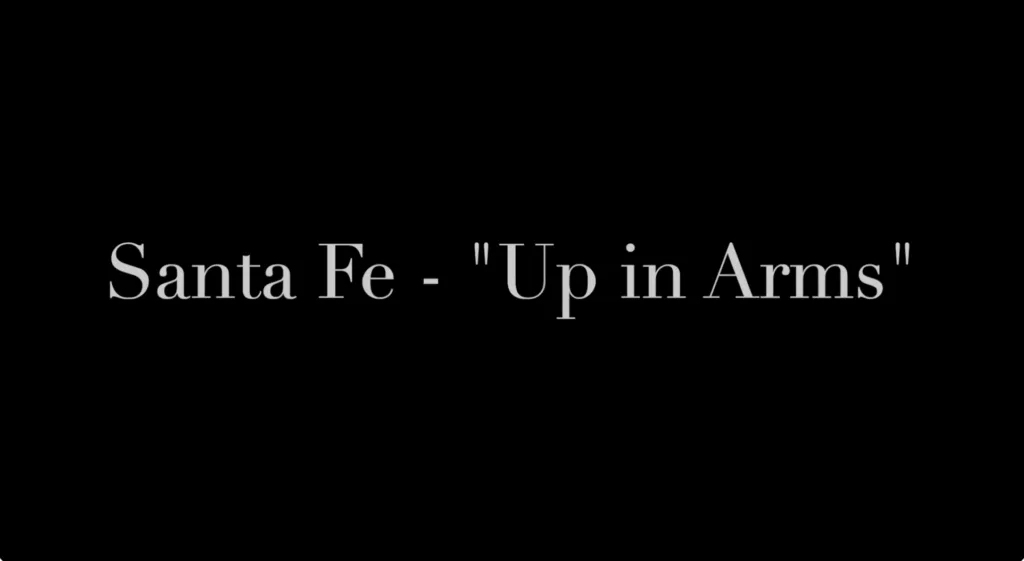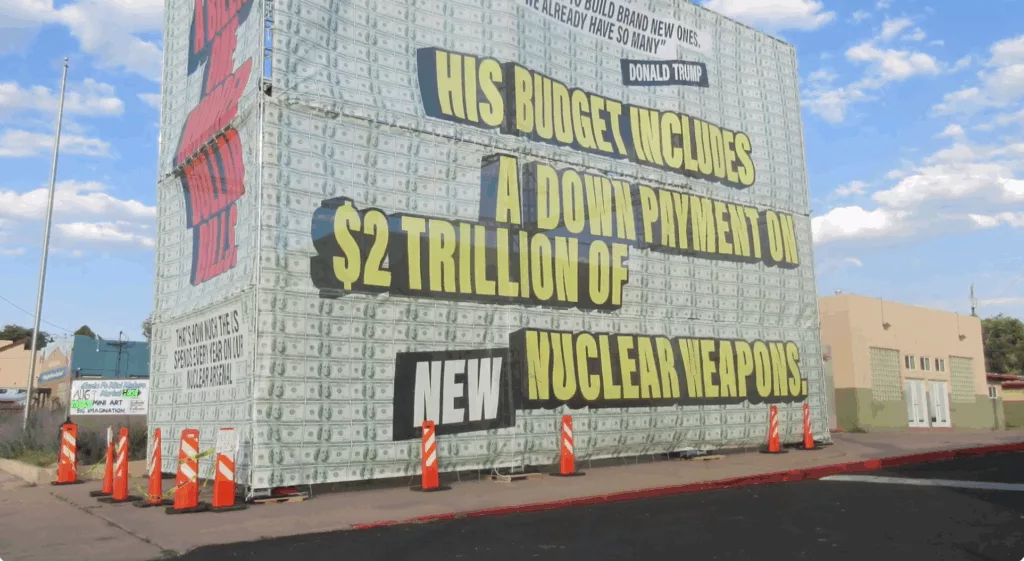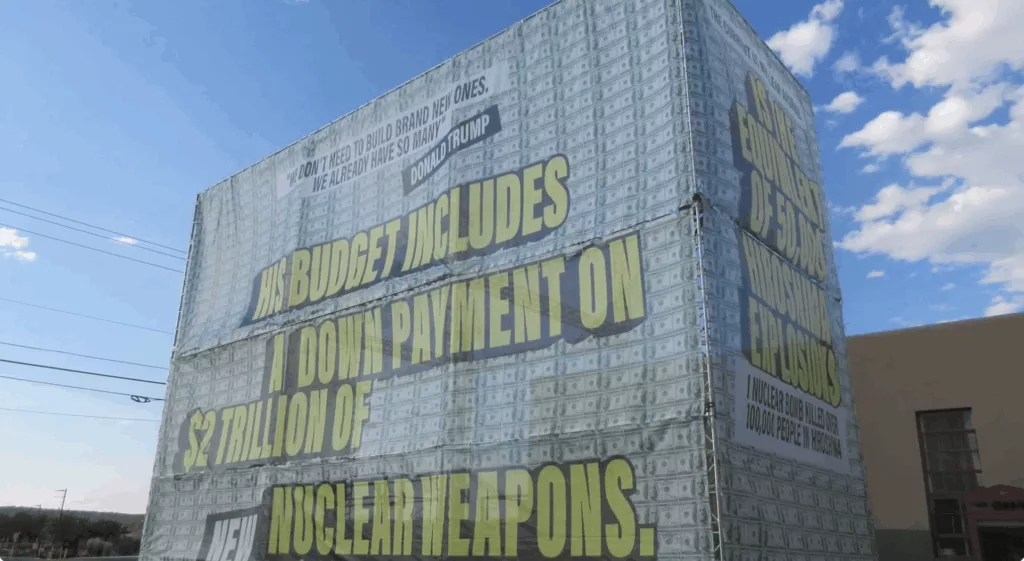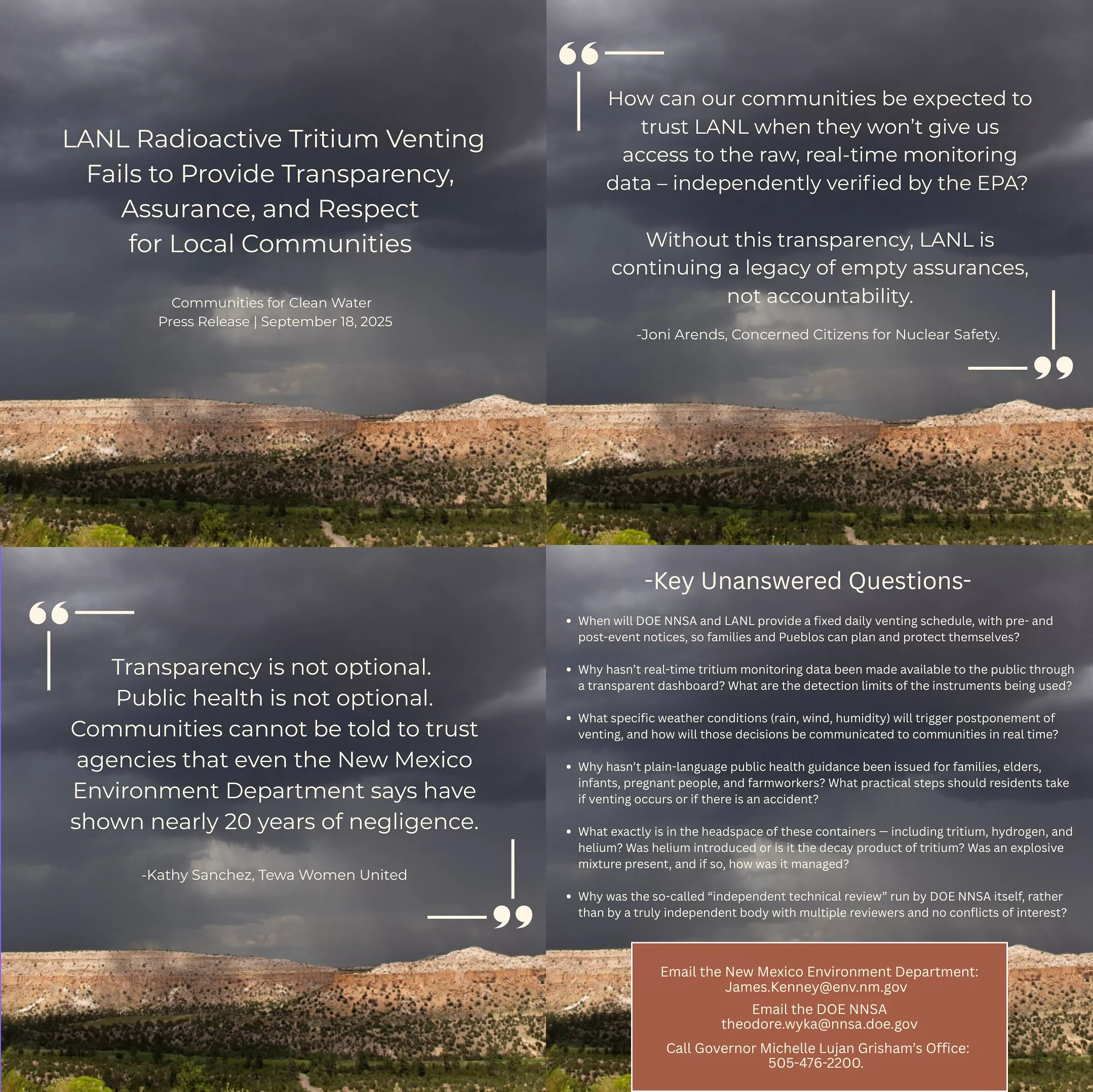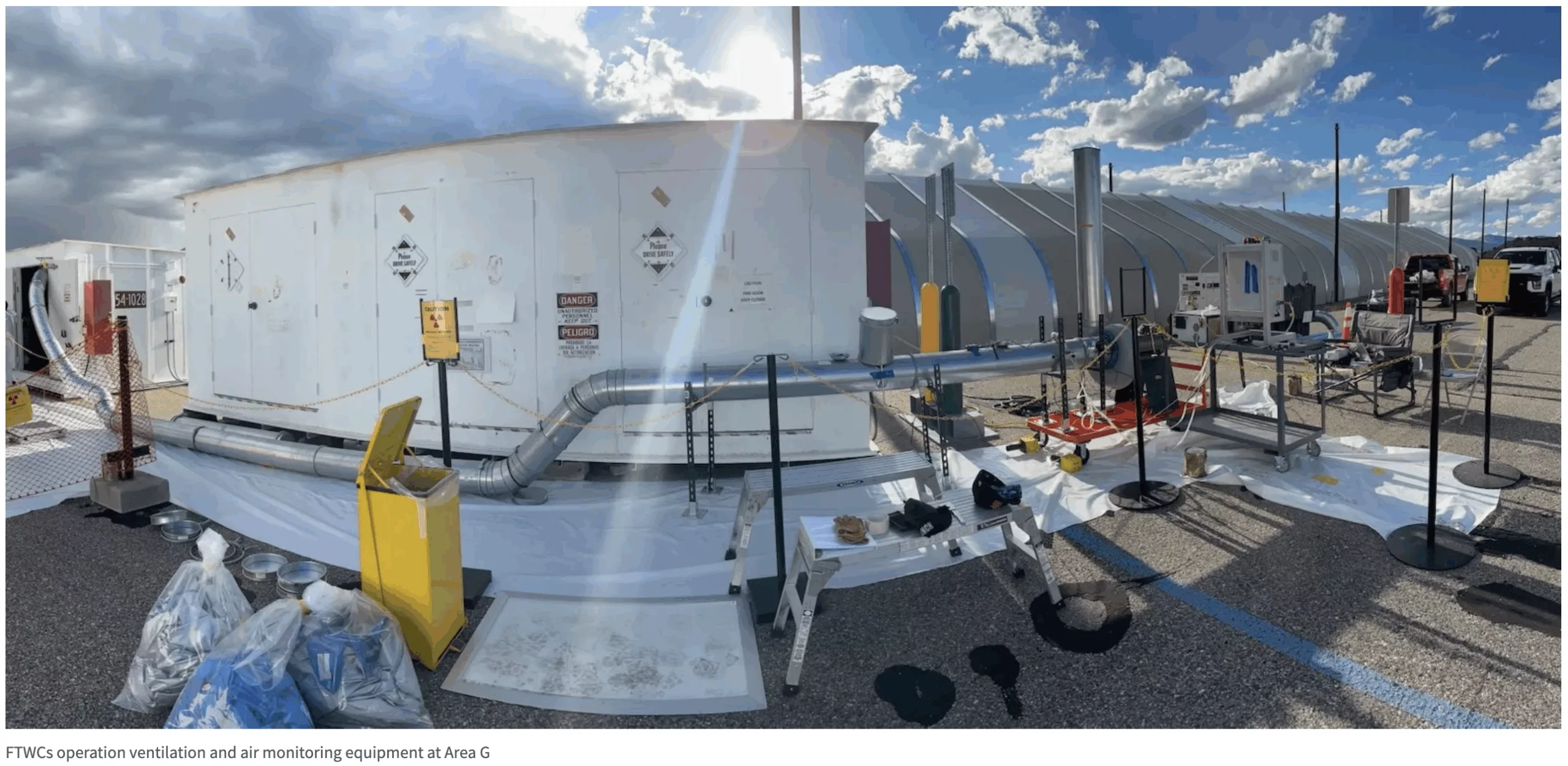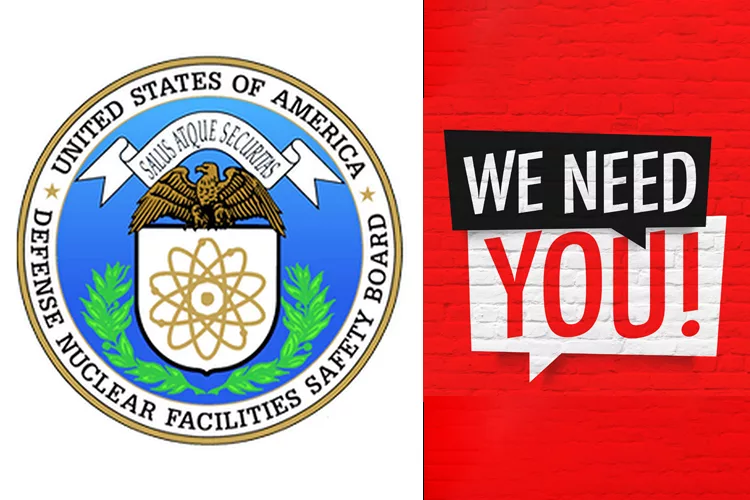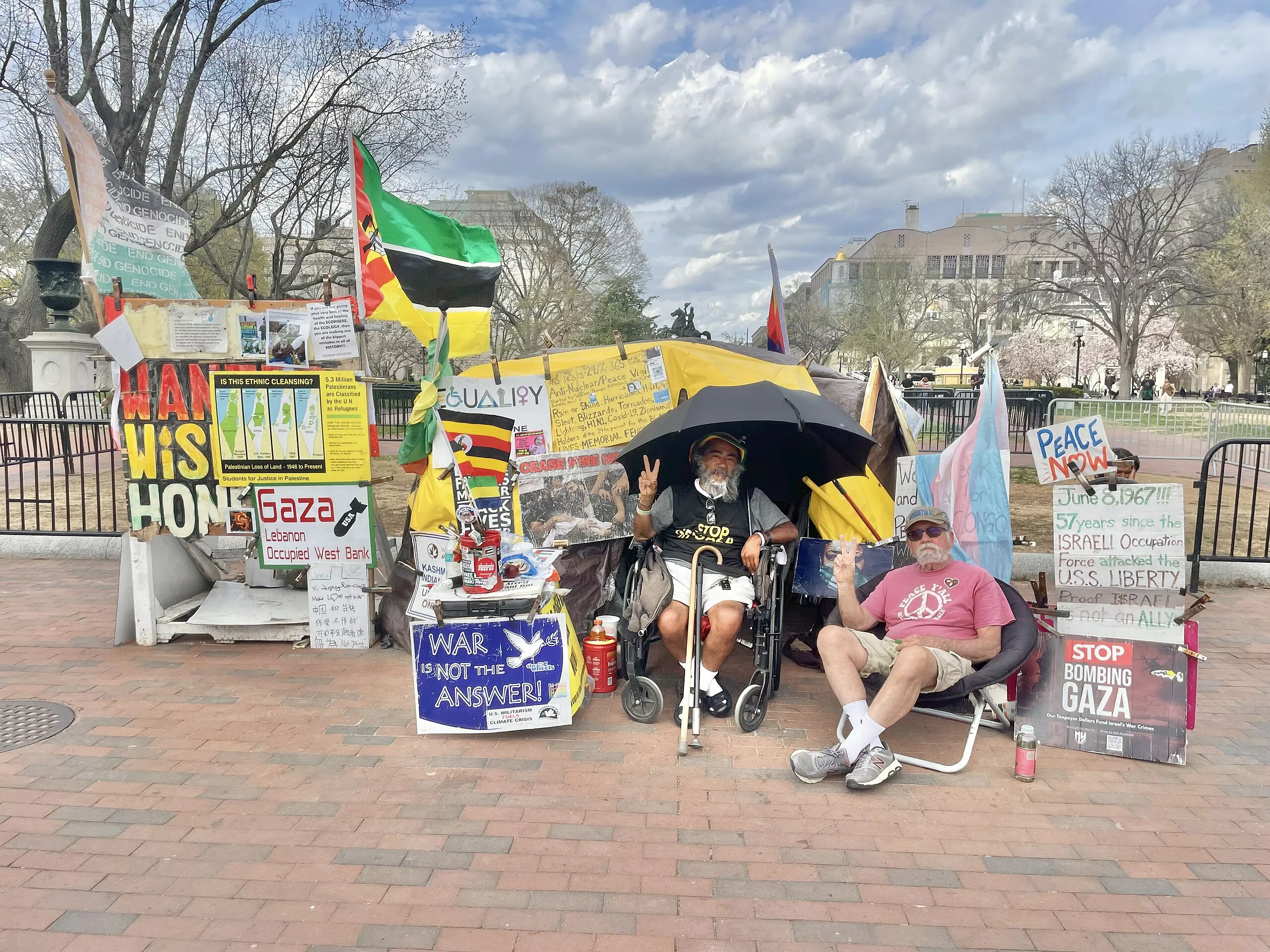Trump talk on nuke testing turns focus to New Mexico’s role in decades of blasts
Jay Coghlan, executive director of the nuclear watchdog group Nuclear Watch New Mexico, said Wright’s comments “somewhat” quelled his initial concerns about a renewed explosive nuclear testing program.
But he said claims Russia and China may be conducting small-scale tests known as hydronuclear tests — banned by the Comprehensive Nuclear Test Ban Treaty, of which the United States, Russia and China are all signatories — continue to give him pause. He fears rumors about the low-yield tests in other nations could be used to justify a domestic return to testing.
“That, in effect, would give permission to the U.S. [to resume testing],” Coghlan said. “But that would be in violation of the norm of the CTBT.”
Three decades removed from the United States’ last nuclear test, a testing regimen would likely be expensive and time-consuming to start up, Coghlan argued, and could prompt other nuclear powers to follow suit.
It seems likely Russia, at least, would: Following Trump’s post, Russian President Vladimir Putin announced if the United States resumed explosive nuclear testing, the Eastern European nation would follow.
“Then everybody else is going to do it, or virtually everybody else will do it, every other nuclear weapons power,” Coghlan said. “I could just see India and Pakistan champing at the bit to test. And then, of course, there’s North Korea and China.”
By Alaina Mencinger amencinger@sfnewmexican.com | November 30, 2025 santafenewmexican.com
It might not have as reverent a name as the Trinity Test or a litany of films made about it. But Project Gnome, a 1961 explosive nuclear test conducted near Carlsbad, is a relic of a bygone era in New Mexico and beyond.
In the 47 years between the Trinity Test and the end of the United States’ explosive nuclear testing in 1992, the nation would perform more than 1,000 such tests — more than any other nuclear nation — with most conducted in Nevada.
New Mexico might not have been the center of the nation’s testing efforts post-Trinity, which marked its 80th anniversary this year, but the state still played a role: Researchers from Sandia National Laboratories and Los Alamos National Laboratory helped design and conduct testing elsewhere, including at the Nevada Test Site and in the Marshall Islands.
Most Democrats and one-third of Republicans think it’s likely the U.S. will get into a nuclear war in the next decade
A new YouGov poll on nuclear weapons finds that nearly half of Americans believe it’s likely the U.S. will get into a nuclear war in the coming decade, and most are worried about personally experiencing a nuclear war. A majority believe nuclear weapons are making the world less safe, but opinions are mixed on whether the U.S. should dismantle all of its nuclear weapons.
By: Jamie Ballard| November 26, 2025 today.yougov.com
46% of Americans think it’s likely the U.S. will get into a nuclear war within the next 10 years; 37% think this is not very or not at all likely. 57% of Democrats and 37% of Republicans think this is likely.
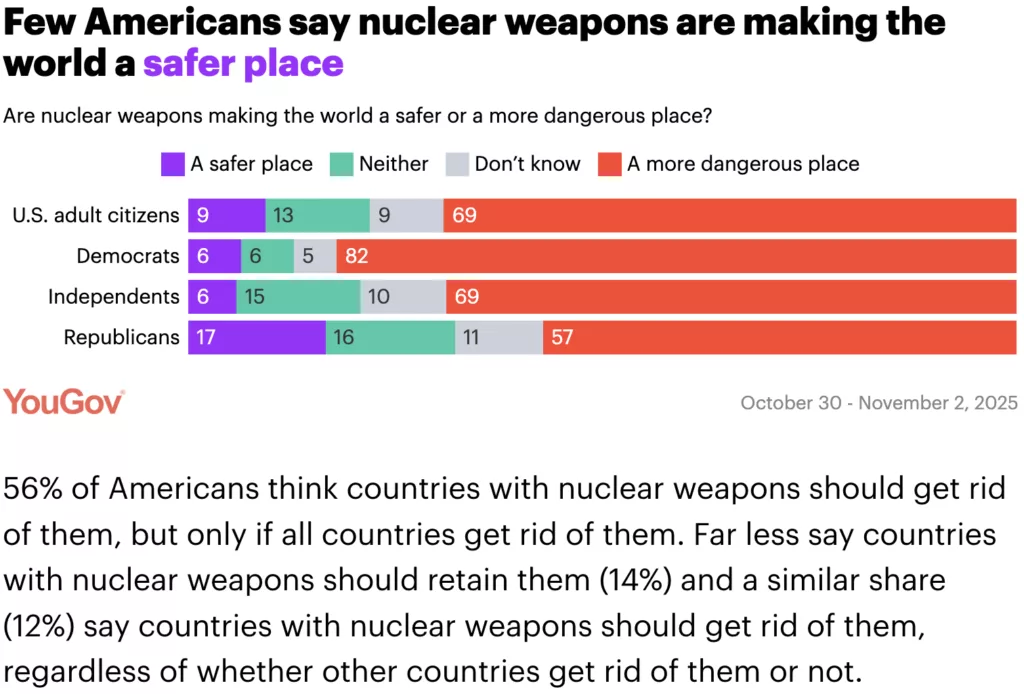
Department of Energy Seeks to Eliminate Radiation Protections Requiring Controls “As Low As Reasonably Achievable”
An internal Department of Energy (DOE) memorandum eliminates worker and public radiation protection rules known “As Low As Reasonably Achievable” (ALARA). This fundamental departure from decades of accepted health physics practices is being promoted by senior DOE political appointees with little background in health or radiation control. It is marked as “URGENCY: High” under the auspices of the DOE Deputy Secretary, the Under Secretary for Science, and the Administrator of the National Nuclear Security Administration. The memorandum awaits the final signature of DOE Secretary Chris Wright.
The memo’s stated goal is to:
“…remove the ALARA principle from all DOE directives and regulations, including DOE Order 458.1, Radiation Protection of the Public and the Environment, NE [Office of Nuclear Energy] Order 458.1, Radiation Protection of the Public, and, upon completion of the rulemaking process, 10 CFR [Code of Federal Regulations] 835, Occupational Radiation Protection.” [1]
It follows the playbook of the Heritage Foundation’s Project 2025, which called for:
“Set[ting] clear radiation exposure and protection standards by eliminating ALARA (“as low as reasonably achievable”) as a regulatory principle and setting clear standards according to radiological risk and dose rather than arbitrary objectives.” [2]
Lab Chromium Contamination Confirmed on San Ildefonso Pueblo Land
Comprehensive Cleanup Needed Instead of More Nuclear Weapons
The New Mexico Environment Department has announced:
“A toxic chromium plume from Los Alamos National Laboratory has spread beyond Lab boundaries onto Pueblo de San Ildefonso land for the first time, with contamination exceeding state groundwater standards… These new results are conclusive evidence that the U.S. Department of Energy’s efforts to contain the chromium plume have been inadequate.”
In reality, chromium groundwater contamination probably migrated beyond the LANL/San Ildefonso Pueblo boundary long ago, with past Lab maps of the plume “magically’ stopping at the border. In the past, tribal leadership has commented that it was fortunate that the contamination stopped there, but that any future indications of groundwater contamination on Pueblo land could have serious consequences. The San Ildefonso Pueblo is a sovereign Native American tribal government.
As late as the late 1990s the Lab was falsely claiming that groundwater contamination was impossible because underlying volcanic tuff is “impermeable.” [1] This ignored the obvious fact that the Parajito Plateau is heavily seismically fractured, providing ready pathways for contaminant migration to deep groundwater. By 2005 even LANL acknowledged that continuing increasing contamination of the regional aquifer is inevitable.[2] Some 300,000 northern New Mexicans rely upon the aquifer for safe drinking water. The potential serious human health effects (including cancer) caused by chromium contamination was the subject of the popular movie Erin Brockovich.
LANL chromium plume spreads onto San Ildefonso Pueblo land, NMED says
Nuclear Watch New Mexico executive direcor Jay Coghlan sees PF-4 as being a bigger scale — and having bigger risks — than the other aging buildings.
“PF-4 is not unique in being old,” Coghlan said. “However, PF-4 is totally unique in currently being the only facility that can process large amounts of plutonium … particularly including plutonium pit production. I think, in part, that’s why the Safety Board focuses more on PF-4 than, to my knowledge, than any other single individual facility.”
By:Patrick Lohmann | November 13, 2025 sourcenm.com
An underground plume of toxic chromium has spread from Los Alamos National Laboratory to Pueblo de San Ildefonso land, state Environment Department officials announced Thursday.
The discovery marks the first time the plume has been detected within the pueblo boundaries, officials said in a news release, though they added the plume’s spread does not pose imminent threats to drinking water in the pueblo or in Los Alamos County. That’s because the plume is not near any known private or public wells, officials said.
Long-term ingestion of hexavalant chromium can cause serious health problems or increase risk of certain cancers.
US Stands Alone Defying UN Vote on Nuclear Test Ban Treaty
Could the LDS Church end an ongoing nuclear weapons project? These veteran activists think so.
By Thalif Deen, Inter Press Sevice | November 12, 2025 ipsnews.net
UNITED NATIONS, Nov 12 2025 (IPS) – The US took another step backward –to break ranks with the United Nations– when it voted against a draft resolution calling for the entry into force of the Comprehensive Nuclear-Test-Ban Treaty (CTBT).
The negative vote followed an announcement by President Trump last month that the US plans to resume nuclear testing after a 33-year hiatus. The US stood alone on the UN vote, which was supported by almost all member States in the General Assembly’s First Committee.
The resolution was adopted by an overwhelming majority: with 168 votes in favor, with one against (United States) and 3 abstentions (India, Mauritius, Syria).
During Trump’s first term, the US abstained on the vote. And in other years they had been voting in favour.
Jackie Cabasso, Executive Director, Western States Legal Foundation, which monitors and analyzes U.S. nuclear weapons programs and policies, told IPS the chaos and uncertainty arose from Trump’s factually-challenged social media post that “because of other countries testing programs, I have instructed the Department of War to start testing our Nuclear Weapons on an equal basis.”
The U.S. government’s first ever “No” vote, on the annual UN resolution in support of the Comprehensive Test Ban Treaty (CTBT), raises further troubling questions about U.S. intentions.
Harking to the MX, Utahns call on LDS Church President Oaks to speak out against nuclear missile being developed in Utah
Could the LDS Church end an ongoing nuclear weapons project? These veteran activists think so.
THE SALT LAKE TRIBUNE | November 9, 2025 sltrib.com
Decades ago, peace activists helped keep a major nuclear weapons system out of Utah with help from key figures, chiefly Spencer W. Kimball, then the president of The Church of Jesus Christ of Latter-day Saints.
Now some of those same individuals are calling on the church’s newly ascended president, Dallin H. Oaks, to follow in his predecessor’s footsteps and speak out against the federal government’s development of a new generation of nuclear missile, known as Sentinel, partly in the Beehive State.
“The arms race continues,” the group of 12 Utahns and one former resident write in a letter mailed to church headquarters in early October, “and a new moral challenge faces” the leaders of the Utah-based faith.
Nuclear Weapons Issues & The Accelerating Arms Race: November 2025
Nuclear weapons:
The government shutdown has impact:
National Nuclear Security Agency confirms 152 furloughed at offices in Albuquerque, Los Alamos
Only 14 employees remain at the two sites By: Danielle Prokop-October 22, 2025
The NNSA confirmed 152 New Mexico employees charged with overseeing national laboratories’ nuclear weapons work were furloughed on Oct. 20, 2025. (Courtesy of NNSA)
The federal government this week sent home more than 150 federal New Mexico employees charged with overseeing national laboratories’ nuclear weapons work, with only 14 employees across two sites remaining at work, the National Nuclear Security Agency confirmed to Source NM.
The furloughs include 71 employees at NNSA’s Los Alamos field office and 81 at the Sandia National Laboratories location, NNSA Deputy Director of Communications Laynee Buckels told Source NM in an email. Seven employees remain at each site, working without pay, she said.
The field offices are responsible for “ensuring compliance with federal contracts to manage and operate the national security assets,” according to the NNSA website
To date there doesn’t appear to be furloughs at LANL, whose employees technically work for a contractor rather than the federal government. Congress is not furloughed, but Speaker Mike Johnson has kept the House out of session. As a result, legislation has come to a screeching halt.
Los Alamos’ plutonium facility safety systems need improvement, oversight board says
Nuclear Watch New Mexico executive direcor Jay Coghlan sees PF-4 as being a bigger scale — and having bigger risks — than the other aging buildings.
“PF-4 is not unique in being old,” Coghlan said. “However, PF-4 is totally unique in currently being the only facility that can process large amounts of plutonium … particularly including plutonium pit production. I think, in part, that’s why the Safety Board focuses more on PF-4 than, to my knowledge, than any other single individual facility.”
By Alaina Mencinger amencinger@sfnewmexican.com | November 7, 2025 santafenewmexican.com
An independent oversight agency wants to see improved safety systems at the facility at the heart of Los Alamos National Laboratory’s plutonium pit mission: PF-4.
The Defense Nuclear Facilities Safety Board reported what it believes to be gaps in a safety analysis drafted for PF-4 and delays in upgrades to safety systems in a letter last month to Energy Secretary Chris Wright.
“Maintaining momentum for these safety infrastructure projects is more important in light of the issues with the safety analysis,” the board wrote in the letter dated Oct. 10. It was signed by former acting chairman Thomas Summers.
LANL Prioritizes Plutonium “Pit” Bomb Core Production Over Safety
The independent Defense Nuclear Facilities Safety Board recently released its Review of the Los Alamos Plutonium Facility Documented Safety Analysis. It concluded that:
“While LANL facility personnel continue to make important upgrades to the Plutonium Facility’s safety systems, many of those projects have encountered delays due to inconsistent funding and other reasons. DOE and LANL should consider prioritizing safety-related infrastructure projects to ensure that the Plutonium Facility safety strategy adequately protects the public, as the facility takes on new and expansive national security missions.” (Page 24)
In early October 2024, the Department of Energy’s semi-autonomous National Nuclear Security Administration (NNSA) announced with great fanfare that the Los Alamos Lab had produced its first “diamond stamped” plutonium pit for the nuclear weapons stockpile. Tens of billions of taxpayers’ dollars have been sunk into LANL’s long delayed and over budget pit production program. Given no further announcements, it is not currently known whether or not the Lab is meeting its congressionally required production goals. Endemic nuclear safety problems have long been an intractable issue, at one point even forcing a three-year halt to plutonium operations at LANL’s Plutonium Facility-4 (“PF-4”).
In its recent Review, the Safety Board reported:
“The [2009] Plutonium Facility safety basis described very large potential [radioactive] dose consequences to the public following seismic events…. DOE committed to upgrade and seismically qualify the ventilation system, with a particular focus on a specific ventilation subsystem…”
“As the only facility in the DOE complex that can process large quantities of plutonium in many forms, [PF-4] represents a unique capability for the nation’s nuclear deterrent. The Board has long advocated for the use of safety-related active confinement systems in nuclear facilities for the purposes of confining radioactive materials…Passive confinement systems are not necessarily capable of containing hazardous materials with confidence because they allow a quantity of unfiltered air contaminated with radioactive material to be released from an operating nuclear facility following certain accident scenarios. Safety related active confinement ventilation systems will continue to function during an accident, thereby ensuring that radioactive material is captured by filters before it can be released into the environment… (Page 2, bolded emphases added)
AP: Trump appears to suggest the US will resume testing nuclear weapons for first time in 30 years
“For Trump, who has cast Russia as a “paper tiger” for failing to swiftly subdue Ukraine, the message is that Russia remains a global military competitor, especially on nuclear weapons, and that Moscow’s overtures on nuclear arms control should be acted on.”
By MICHELLE L. PRICE and CHRIS MEGERIAN | October 30, 2025 apnews.com
BUSAN, South Korea (AP) — President Donald Trump appeared to suggest the U.S. will resume testing nuclear weapons for the first time in three decades, saying it would be on an “equal basis” with Russia and China.
The Kremlin pointed out that a global ban on nuclear tests has remained in place, but warned that if any country resumes nuclear testing Russia would follow suit.
There was no indication the U.S. would start detonating warheads, but Trump offered few details about what seemed to be a significant shift in U.S. policy.
He made the announcement on social media minutes before he met with Chinese leader Xi Jinping on Thursday in South Korea. He offered little clarity when he spoke to reporters later aboard Air Force One as he flew back to Washington.
The U.S. military already regularly tests its missiles that are capable of delivering a nuclear warhead, but it has not detonated the weapons since 1992. The Comprehensive Nuclear Test Ban Treaty, which the U.S. signed but did not ratify, has been observed since its adoption by all countries possessing nuclear weapons, North Korea being the only exception.
REUTERS: Trump tells Pentagon to immediately resume testing US nuclear weapons
“Russia – which tested a new nuclear-powered cruise missile on October 21, held nuclear readiness drills on October 22 and tested a new nuclear-powered autonomous torpedo on October 28 – said it hoped Trump had been properly informed that Moscow had not tested a nuclear weapon itself.”
By Trevor Hunnicutt, Ismail Shakil and Kanishka Singh | October 30, 2025 reuters.com
VIEW THE RECORDING: Santa Fe Ecumenical Conversations Towards Nuclear Disarmament at Santa Maria de la Paz Catholic Community – Monday, October 27
Archbishop John C. Wester and NukeWatch New Mexico presented a special evening at Santa Maria de la Paz Catholic Community on Monday, October 27, from 6:00 to 8:00 p.m. MT. Following a presentation from NukeWatch executive director Jay Coghlan on U.S. nuclear weapons “modernization,” the Archbishop shared reflections from his pastoral letter, Living in the Light of Christ’s Peace, and speak about the importance of dialogue and hope in working toward nuclear disarmament.
View the recording at https://www.youtube.com/watch?v=9LFmQzMoJds&t=1s
Trump Orders Nuclear Weapons Testing for New Nuclear Arms Race
New Plutonium “Pit” Bomb Cores at Los Alamos Lab Could Make It Real
Just minutes before meeting with Chinese President Xi Jinping, Trump posted on his Truth Social media platform that “Because of other countries testing programs, I have instructed the Department of War to start testing our Nuclear Weapons on an equal basis. That process will begin immediately.” House Speaker Mike Johnson soon followed on CNN saying, “I think it is an obvious and logical thing to ensure that our weapons systems work.”
No other countries are currently testing nuclear weapons (the last was by North Korea in 2017). Further, any nuclear weapons tests by the U.S. would be performed by the Department of Energy (whose last test was in 1992), not the Department of War (until recently the Department of Defense). Trump was likely referring to Vladimir Putin’s recent claims of a new nuclear powered cruise missile and a tsunami-causing nuclear-armed torpedo that could threaten America’s coastal cities. In addition, China is dramatically expanding its own fleet of intercontinental ballistic missiles.
But central to all this is the U.S.’ own $2 trillion “modernization” program that will rebuild every nuclear warhead in the planned stockpile with new military capabilities and produce new-design nuclear weapons as well. This so-called modernization program will also build new nuclear weapons production facilities expected to be operational until ~2080, and buy new missiles, subs, and bombers from the usual rich defense contractors, all to keep nuclear weapons forever.
‘Nuclear weapons are blasphemous’: Archbishop Wester continues disarmament push with talk
This event was organized by the “Santa Fe Ecumenical Conversations Towards Nuclear Disarmament” group at the Santa Maria de la Paz parish near the Santa Fe Community College. They kindly invited NukeWatch to speak before Archbishop Wester for what turned out to be a wonderful event. The full recording can be viewed at https://www.youtube.com/@SMDLP/streams
By Cormac Dodd cdodd@sfnewmexican.com | October 28, 2025 santafenewmexican.com
Despite saying he has received a somewhat muted response from the local faithful, Santa Fe’s Catholic archbishop is still pushing nuclear disarmament as vital to humanity’s spiritual well-being and continued existence.
“I think nuclear weapons are blasphemous, because I think nuclear weapons are humanity’s attempt to build a Tower of Babel, an attempt to eat from the apple of the tree of the Garden of Eden, to become like God, to become gods,” Archbishop John C. Wester said in a roughly 30-minute address at Santa Maria de la Paz Catholic Church south of Santa Fe.
“In humility, we must avoid inventing anything that, in a matter of hours, can destroy what God has created,” the leader of the Archdiocese of Santa Fe continued. “The story of Adam and Eve is archetypal, I think: When human beings try to become as God, they lose the Garden of Eden and they must endure the cruel reality of paradise lost.”
The archbishop’s comments followed a journey he undertook to Japan on the 80th anniversary of the U.S. military’s decision to drop atomic bombs on Hiroshima and Nagasaki toward the end of World War II. He spoke in front of an audience of about 50 people — who gave Wester a standing ovation — at Monday’s event
In a Looming Nuclear Arms Race, Aging Los Alamos Faces a Major Test
The lab where Oppenheimer developed the atomic bomb is the linchpin in the United States’ effort to modernize its nuclear weapons. Yet the site has contended with contamination incidents, work disruptions and old infrastructure.
By Alicia Inez Guzmán | October 28, 2025 The New York Times nytimes.com
In a sprawling building atop a mesa in New Mexico, workers labor around the clock to fulfill a vital mission: producing America’s nuclear bomb cores.
The effort is uniquely challenging. Technicians at Los Alamos National Laboratory must handle hazardous plutonium to create the grapefruit-size cores, known as pits. They do so in a nearly 50-year-old building under renovation to address aging infrastructure and equipment breakdowns that have at times disrupted operations or spread radioactive contamination, The New York Times found.
Now, the laboratory is under increasing pressure to meet the federal government’s ambitions to upgrade the nation’s nuclear arsenal. The $1.7 trillion project includes everything from revitalizing missile silos burrowed deep in five states, to producing new warheads that contain the pits, to arming new land-based missiles, bomber jets and submarines.
But the overall modernization effort is years behind schedule, with costs ballooning by the billions, according to the Congressional Budget Office. In 2018, Congress charged Los Alamos with making an annual quota of 30 pits by 2026, but by last year it had produced just one approved for the nuclear stockpile. (Officials have not disclosed whether more have been made since then.)
*The featured image differs from the article photo due to usage rights.
Why Putin’s ‘invincible’ nuclear-powered missile is more likely to become a disastrous ‘flying Chernobyl’ for Russia
The US abandoned efforts to build nuclear-powered missile weapons during the 1950s arms race with the Soviet Union as a nuclear-powered missile would effectively be a huge radiation risk.
Jeffrey Lewis, a nuclear nonproliferation expert at Middlebury College, described it as a “tiny flying Chernobyl,” referencing the Soviet power plant that melted down and covered a 1,600-mile area with toxic radiation…While Lewis believes the Burevestnik is only capable of subsonic speed and easy to intercept, he warned that Russia’s ambition poses a return to the Cold War era.
“NATO aircraft could intercept it. The problem is that Burevestnik is yet another step in an arms race that offers no victory for either side,” he wrote on X.
By Ronny Reyes | October 28, 2025 nypost.com
Russian strongman Vladimir Putin’s latest threats that Moscow is preparing to deploy its new “invincible” nuclear-powered cruise missile has drawn a rebuke from President Trump and a reminder of America’s own nuclear might.
But experts say the Burevestnik missile could end up being more like a disastrous “flying Chernobyl” for Russia — and proves Putin is actually nervous about the possibility of the US giving Tomahawk cruise missiles to Ukraine.
George Barros, of the Washington-based Institute for the Study of War, described Putin’s ominous Sunday announcement as a form of fear mongering from a Kremlin afraid that the US could give Kyiv a much more conventional weapon — the tried and true Tomahawk.
Russia tested new nuclear-powered Burevestnik cruise missile
“For Trump, who has cast Russia as a “paper tiger” for failing to swiftly subdue Ukraine, the message is that Russia remains a global military competitor, especially on nuclear weapons, and that Moscow’s overtures on nuclear arms control should be acted on.”
By Guy Faulconbridge and Lidia Kelly Tim Balk | October 26, 2025 reuters.com
- Russia tests nuclear-capable Burevestnik missile
- Missile flew for 14,000 km, 15 hours
- Putin says it can pierce any missile defences
Trump Administration Providing Weapons Grade Plutonium to Sam Altman
“If there were adults in the room and I could trust the federal government to impose the right standards, it wouldn’t be such a great concern, but it just doesn’t seem feasible.”
By: Joe Wilkins | October 24, 2025 futurism.com
With the economy the way it is these days, it’s nice to have a little walking around money.
Donald Trump certainly thinks so. Since his return to the White House, the president has labeled 440 federal properties for possible sale, leased 13.1 million acres of public land for strip mining, and held a fire sale for satellites developed by NASA’s Jet Propulsion Lab.
In one of his wildest money moves to date, the Financial Times reports that Trump is now offering companies access to plutonium from America’s arsenal of cold war nuclear missiles.
On Tuesday, the US Department of Energy (DOE) launched an application for interested parties to apply for access to a maximum of 19 metric tonnes — a little under 42,000 pounds — of weapons-grade plutonium, which has long been a key resource undergirding the US nuclear arsenal.
One of the companies anticipated to receive shipments of the fissile isotope from the DOE is Oklo, a “nuclear startup” backed — and formerly chaired — by OpenAI CEO Sam Altman. Earlier in October, Oklo was one of four US companies chosen by the DOE to join a new pilot program meant to rush the testing and approval of experimental reactor designs.
As the FT reports, we won’t know for certain until December 31, when the DOE announces the companies selected to purchase the plutonium, but it’s likely Oklo will be among them. That’s stirring up plenty of anxiety throughout the scientific community, who say the relaxed approach to nuclear development is a major cause for alarm.
“If there were adults in the room and I could trust the federal government to impose the right standards, it wouldn’t be such a great concern, but it just doesn’t seem feasible,” Edwin Lyman, a physicist with the Union of Concerned Scientists told the FT.
U.S. Agency That Protects Nuclear Arsenal to Furlough Workers
Jay Coghlan, the executive director of Nuclear Watch New Mexico, a private group that monitors the agency, said it was unclear if the furloughs would have any immediate effect on nuclear safety. “As a baseline, the nuclear safety officers have always been understaffed. There is simply not enough federal oversight as is. And then you’re talking about furloughing more,” he added.
By Tim Balk | October 17, 2025 nytimes.com
![]() The National Nuclear Security Administration said 1,400 workers would be affected by Monday.
The National Nuclear Security Administration said 1,400 workers would be affected by Monday.
Nuclear weapons safety oversight in decline with Trump, Biden inaction
The lone independent federal agency responsible for ensuring safety at U.S. nuclear weapons sites — including Hanford in Washington state — will lose its ability to issue recommendations for safer work by January if the Trump administration doesn’t replenish its board, which this month dwindles to one member.
By Patrick Malone | October 15, 2025 seattletimes.com
The Defense Nuclear Facilities Safety Board ensures adequate public health and worker safety by scrutinizing hazardous work conducted by the U.S. Department of Energy and its contractors that produce and maintain the nuclear arsenal. If the Trump administration and Congress don’t move quickly to populate the board, it will be incapable of issuing formal safety recommendations to the Energy Department, according to a report last month from the Government Accountability Office, Congress’ investigative arm.
If the board is without a quorum of at least three members for a year, “the agency would essentially be able to offer only nonbinding advice to DOE,” according to the report.
“The whole idea of having the board in place is to provide the optics in addition to the substance,” Nathan Anderson, a Washington state-based director in the GAO’s natural resources division, told The Seattle Times.
The board does not have regulatory or enforcement authorities, but its advice carries significant weight and cannot be easily dismissed or disregarded, the GAO report states. The board’s recommendations to the U.S. secretary of energy are published for public comment, and the secretary must respond in writing. The board also reports each year to selected congressional committees on its recommendations to the Energy Department and any outstanding safety problems.
FULL ORIGINAL ARTICLE (SEATTLE TIMES)
YOU CAN HELP SAVE THE DNFSB TODAY:
Continue reading
New Article about “Participatory Democracy in Action” Describes WIPP Permit Negotiations
Thanks to our friends at Concerned Citizens for Nuclear Safety for this article:
In an essay for NYU’s Democracy Project, David F. Levi, a former federal judge and director emeritus of the Bolch Judicial Institute at Duke Law, reflected on the negotiations he facilitated in New Mexico about the renewal of the hazardous waste permit for the Waste Isolation Pilot Plant (WIPP), a deep geologic repository for plutonium-contaminated waste generated in the fabrication of nuclear weapons. Judge Levi’s essay is entitled “Participatory Democracy in Action.” He wrote:
 “A couple of years ago, I was asked to mediate a dispute between the U.S. Department of Energy (DOE) and the New Mexico Environment Department (NMED) concerning the renewal of a required state permit for DOE’s Waste Isolation Pilot Plant (WIPP), the nation’s only deep underground nuclear waste storage facility, located outside of Carlsbad, New Mexico. I thought I could help the two government entities but quickly came to realize that under the mediation procedures followed by New Mexico, the mediation would also involve citizen groups whose ultimate concurrence was essential to any complete resolution. This was entirely new to me.
“A couple of years ago, I was asked to mediate a dispute between the U.S. Department of Energy (DOE) and the New Mexico Environment Department (NMED) concerning the renewal of a required state permit for DOE’s Waste Isolation Pilot Plant (WIPP), the nation’s only deep underground nuclear waste storage facility, located outside of Carlsbad, New Mexico. I thought I could help the two government entities but quickly came to realize that under the mediation procedures followed by New Mexico, the mediation would also involve citizen groups whose ultimate concurrence was essential to any complete resolution. This was entirely new to me.
“In this case, there were seven such citizen groups entitled to participate and representing a variety of points of view. There was one group representing some of the government and business leaders of the town of Carlsbad who favored permit renewal on terms ensuring the continued long-term operation of WIPP. There were six groups expressing a variety of concerns about nuclear waste coming to New Mexico. They sought a more restrictive permit.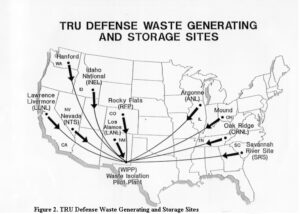
“To my astonishment, over the course of four full days, we worked through the multitude of issues and came to complete agreement. Something magical had happened. Thanks to the goodwill of the DOE and its contractor, the remarkable daily attendance and attentiveness of the NMED Secretary and the measured and well-informed way in which the various citizen groups made their points, we were able to find consensus and craft permit language that was acceptable to everyone.
“For me, as a former judge and mediator, the experience was thrilling. It was an experience of participatory democracy in action that made me proud of our fellow citizens and our government. Three aspects of the experience stand out. First, everyone in the room had taken responsibility for the way in which our nation’s only deep underground nuclear storage facility would be operated for the next 10 years. The citizen participants were not just making suggestions; they were assuming many of the attributes of decision makers. Second, all participants were advocating, compromising, and collaborating on behalf of what they saw as the public interest. These are the essential skills of democracy—the civic virtues so central to the Founders’ vision of what would make democracy work in America—and they require practice. Finally, over four days around a table, the citizens were able to take the measure of the DOE and NMED representatives. They came to realize, as I did, that these public servants, as well as the DOE contractor, were very well-informed, experienced, and intentioned. The government representatives had a similar experience of coming to appreciate the citizen questions and points of view. A government that relies on trust needs this kind of interaction to maintain that trust.
“It seems our democracy would be strengthened if we could extend the benefits of this kind of participatory structure to other areas of our legal and regulatory systems.”
“In Democracy in America, Alexis de Tocqueville made some of these points in reference to the jury trial in civil cases. He emphasized the importance of the civil jury trial as a free “public school” [https://contextus.org/Tocqueville,_Democracy_in_America_(1835),_Book_I,_Chapter_XVI_Causes_Mitigating_Tyranny_In_The_United_States_(Part_II).13?ven=Gutenberg&lang=en]  educating jurors in the democratic virtues and skills and teaching them to assume responsibility. In the same vein, every trial judge I know would attest to the importance of the jury experience for building confidence in the courts. After a trial, judges often hear words of gratitude from jurors who are deeply impressed by the legal process and are honored to have participated despite their initial dismay at being called to jury service. Sadly, the number of jury trials has diminished, particularly in federal court. Reversing that trend is a worthy goal, particularly for a branch of government that depends so heavily on public confidence.
educating jurors in the democratic virtues and skills and teaching them to assume responsibility. In the same vein, every trial judge I know would attest to the importance of the jury experience for building confidence in the courts. After a trial, judges often hear words of gratitude from jurors who are deeply impressed by the legal process and are honored to have participated despite their initial dismay at being called to jury service. Sadly, the number of jury trials has diminished, particularly in federal court. Reversing that trend is a worthy goal, particularly for a branch of government that depends so heavily on public confidence.
“As a final reflection: any persons involved as litigants will have an experience of the legal system. The experience can advance their sense of agency and participation, their ability to disagree civilly, and their trust in the courts. But how can these objectives be obtained when so many Americans cannot afford a lawyer? We can do so much better to provide understanding of and access to our justice system.”
The six New Mexico based non-governmental organizations were Citizens for Alternatives to Radioactive Dumping (CARD), Concerned Citizens for Nuclear Safety (CCNS), Conservation Voters New Mexico (CVNM), Nuclear Watch New Mexico, Southwest Alliance for a Safe Future (SAFE), and Southwest Research and Information Center (SRIC). The individual was Steve Zappe, a grandfather and former NMED WIPP Program Manager.
“A House of Dynamite” New Netflix Nuclear Catastrophe Film: Fiction, for Now
The reviews are rolling in for “A House of Dynamite,” which premiered in Europe earlier this month before coming to the U.S. on October 10th, with a full Netflix release scheduled for the 24th. Here’s the trailer, and see the schedule for Santa Fe theater showings here:
This Week! Santa Fe Theater Screenings for the Film “A House of Dynamite”
I attended one of these screenings last night, and I’ll let the professional critic reviews give the gist:
The Kathryn Bigelow thriller looks at what might happen if a ballistic missile were headed to the U.S. The director hopes the movie will start a conversation. New York Times: At Venice, ‘A House of Dynamite’ Is Scarier Than Most Horror Films
“The Netflix thriller captures from multiple perspectives the White House response to an unattributed missile launch headed for a major U.S. city in the harrowing 20 minutes until projected impact…”An unrelenting chokehold thriller so controlled, kinetic and unsettlingly immersive that you stagger out at the end of it wondering if the world will still be intact.” ‘A House of Dynamite’ Review: Idris Elba and Rebecca Ferguson in Kathryn Bigelow’s Precision-Tooled, Viscerally Unsettling Nail-Biter
“Told from the perspective of soldiers at a remote Alaskan missile base, staffers in the White House situation room, military officials at US Central Command (CENTCOM), and the president of the United States, the film weaves an overlapping timeline to show how the United States would respond to a missile attack…The film doesn’t want viewers to ask themselves how to thwart a nuclear attack on the United States. Rather, it wants the viewer to question the value of having nuclear weapons at all. ‘None of this makes sense,’ the President (Idris Elba) bemoans, ‘Making all these bombs and all these plans.'”
“A House of Dynamite is a terrifying examination of how terribly wrong things can go even with highly competent people in charge…But that’s also not necessarily the world we’re living in…The film shows why the worst can happen, even when competent, well-meaning people are trying to do the right thing.
But what if competence and decency are in short supply?” A House of Dynamite: Bigelow’s latest thriller shows why nuclear bombs are only part of the danger
This film left me reeling with tension and anxiety and exactly as the Times article titles it, is scarier than most horror films. Unlike ‘Oppenheimer,’ which largely glorified the invention of the atomic weapon, ‘A House of Dynamite’ makes it impossible to ignore the threat that nuclear weapons pose to our world. Working backwards from perspectives, and focused on how we can actually improve our odds of keeping this story a fictional one, here is what struck me most about this film:
-
-
Only one person decides what happens. But the real threat isn’t one reckless leader — it’s a reckless system. The final segment of the film features the “nuclear football” heavily, a briefcase containing launch procedures and options. In the United States, the president holds the sole and absolute authority to order the use of nuclear weapons. In the film, there are many voices in the President’s ear, but two primary perspectives quickly emerge after the defense fails and the ICBM remains inbound to its U.S. target: “One side advocates a retaliatory strike; the other, nothing. ‘It’s surrender or suicide,’ one adviser tells the President,” – thebulletin.org. The military aide carrying the nuclear football is tasked with providing the President the list of options if retaliation is chosen. An absolute must-read, Daniel Ellsberg’s book “The Doomsday Machine” breaks down many of the themes in the film with pure and terrifyingly honest account of Cold War-era nuclear strategy. In terms of launch authority, he describes how the inherent instability of the delegated command structure of the nuclear apparatus makes accidental or unwanted war an ever-present danger.
-
LANL tritium containers to head to Texas after last treatment
Four flanged tritium waste containers have been depressurized and transported to Los Alamos National Laboratory’s Weapons Engineering Tritium Facility, where they will be treated further before heading out-of-state for disposal.
By Alaina Mencinger amencinger@sfnewmexican.com | October 15, 2025 santafenewmexican.com
The containers’ final destination is Waste Control Specialists, a West Texas facility that handles the storage and disposal of radioactive waste.
The more than 1,300-acre facility in Andrews County is located on an approximately 14,000 acre property, which is sited on a thick clay formation which the company describes as “nearly impermeable.”
New documents have been added to the Los Alamos Legacy Cleanup Contract Electronic Public Reading Room.
All legacy cleanup documents required to be posted after April 30, 2018, are available on the site linked above.
For legacy cleanup documents that were posted prior to April 30, 2018, please visit the LANL electronic public reading room.
- Review, Notice of Completion of Off-Site Waste Shipments for Final Disposal, Activities 3.1.5, 3.1.8, and 3.3.4, Compliance Plan, Site Treatment Plan, Federal Facility Compliance Order Los Alamos National Laboratory [July 31, Aug. 21, 2025]
https://ext.em-la.doe.gov/GovFTPFiles/api/GetFiles/GetFile?fileName=EMID-703933_NMED_Review_STP_Shpmt_Jul_31_Aug_21_101525.pdf
Strong Political and Public Opposition Means Consolidated Interim Storage Facility (CISF) in NM “Impossible in the Near Future”
NEW UPDATE OCTOBER 10, 2025:
Holtec abandons plan to build New Mexico storage facility for spent nuclear fuel
This is excellent news. The Governor and state legislature (specifically Senator Jeff Steinborn and Representative McQueen) are to be commended for not allowing New Mexico to become the nation’s dumping ground for highly radioactive commercial spent fuel rods, especially when the Land of Enchantment has never had its own nuclear energy plant. Hard work from many New Mexicans made this happen.
So-called “interim” storage would never be interim when the federal government has failed for more than four decades to find a permanent repository for these lethal wastes. This also shows how hollow all the hype is about the claimed renaissance of nuclear power, when on the front end the industry can’t survive without taxpayer handouts, and on the back end can’t solve its radioactive waste problem.
Holtec’s quote that “New Mexico’s acquiescence is necessary” for interim storage to go forward is interesting, implying that we have to surrender as the nuclear colony that we are. Well, guess what, we didn’t surrender, and I predict you’ll see more of this. Moreover, whether you’re pro-nuclear or anti-nuclear, Holtec is an ethically questionable company, which is why the attorneys general of New Jersey and Massachusetts have sued it.
Adiós and good riddance, Holtec!
New York Times: Tax Break Scandal Leads to $5 Million Fine for N.J. Energy Company
SEE MORE:
Nuclear Weapons Issues & The Accelerating Arms Race: September 2025
Nuclear Weapons Update:
Putin has offered Trump a one-year extension of the numerical cap on strategic nuclear weapons in the new Strategic Arms Reduction Treaty which is 1,550 warheads (however, B52s are counted as one warhead while they can carry a dozen). New START expires in February 2026, which will be the first time the world will be without any nuclear arms control treaties since the mid-1970s. Trump has said it sounded like a good idea.
Note: New START ratification in 2010 provided the opportunity for Republicans in the Senate to attach the condition of $88 billion for nuclear weapons “modernization” that has since metastasized to ~$2 trillion. Nuclear disarmament must be prioritized as the ultimate goal over simply continued arms control.
A mere extension of the numerical cap would not involve Congressional ratification. The extension of New START’s numerical cap is in part to allow for a year in which to begin negotiations for a treaty replacement.
Plutonium Pit Production:
A draft plutonium pit production programmatic environmental impact statement is expected to be released next year in early 2026.
Accelerating Arms Race:
Is North Korea set to become world’s ‘fourth ICBM power’ after missile breakthrough? | Park Chan-kyong | South China Morning Post | September 11, 2025
A new era in North Korea’s missile programme may be dawning, as analysts warn of an imminent test launch of an intercontinental ballistic missile capable of carrying multiple warheads to the US mainland. Fresh from his appearance at China’s Victory Day parade in Beijing last week, North Korean leader Kim Jong-un personally oversaw the trial of a lighter, more robust solid-fuel ICBM engine, state media reported on Tuesday, touting the achievement as a “strategic” breakthrough.
Saudi Arabia signs a mutual defense pact with nuclear-armed Pakistan after Israel’s attack on Qatar | MUNIR AHMED & JON GAMBRELL | AP NEWS | September 18, 2025
DUBAI, United Arab Emirates (AP) — Pakistan’s defense minister says his nation’s nuclear program “will be made available” to Saudi Arabia if needed under the countries’ new defense pact, marking the first specific acknowledgment that Islamabad had put the kingdom under its nuclear umbrella.
Defense Minister Khawaja Mohammad Asif’s comments underline the importance of the pact struck this week between Pakistan and Saudi Arabia, which have had military ties for decades.
The move is seen by analysts as a signal to Israel, long believed to be the Middle East’s only nuclear-armed nation. It comes after Israel’s attack targeting Hamas leaders in Qatar last week killed six people and sparked new concerns among Gulf Arab nations about their safety as the Israel-Hamas war devastated the Gaza Strip and set the region on edge.
Russia suspected of helping North Korea build nuclear submarines, Seoul investigating | Park Chan-kyong | South China Morning Post | September 18, 2025
South Korea is investigating reports that Russia has supplied North Korea with nuclear submarine reactor modules, a move analysts see as highly plausible and one that could mark a breakthrough in Pyongyang’s decades-long push for a nuclear-powered navy… At the 8th Party Congress in January 2021, North Korea declared five core defence goals, including the development of nuclear-powered submarines and submarine-launched strategic nuclear weapons.
China Hardens Military Stance Against U.S. With Nuclear Weapons and Tough Talk | Brian Spegele | The Wall Street Journal| September 18, 2025
China played down its rapidly rising military might for years. In the past few weeks, Beijing has broadcast a steady drumbeat of firepower displays and muscular rhetoric, carrying an unmistakable warning for the U.S… Part of China’s confidence stems from the rapid growth of its firepower. The Pentagon estimates that China’s stockpile of nuclear warheads has more than doubled since 2020, alongside a growing array of options to launch those weapons, from mobile ground-launch systems to increasingly stealthy submarines.
Holtec Pulls Out of New Mexico Spent Nuclear Fuel Interim Storage Project
Holtec International has confirmed it is canceling plans to build a consolidated interim storage facility for spent nuclear fuel in southeastern New Mexico.
By Radwaste Solutions | October 9, 2025 ans.org
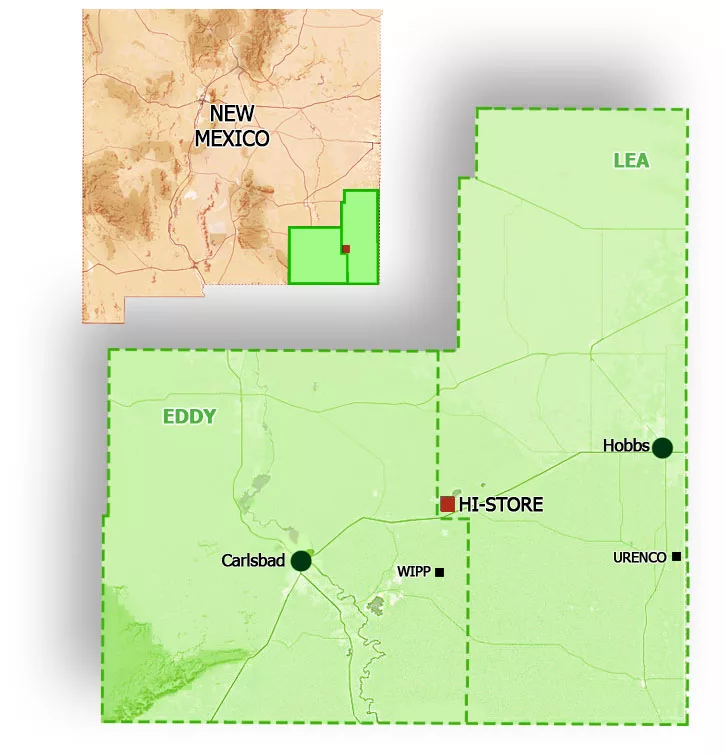
Named the HI-STORE CISF, the facility would have stored up to 10,000 canisters of commercial SNF on land owned by the Eddy-Lea Energy Alliance (ELEA) near the towns of Carlsbad and Hobbs.
“After discussions with our longtime partner in the HI-STORE project, the Eddy-Lea Energy Alliance, and due to the untenable path forward for used fuel storage in New Mexico, we mutually agreed upon canceling the agreement. This allows for ELEA to work to redevelop the property in a manner that fits their needs and allows Holtec to work with other states who are amenable to used fuel storage based on the recent DOE work on public education and outreach,” Holtec said in a statement (emphasis added).
Following the U.S. Supreme Court’s June ruling in NRC v. Texas, which found that petitioners did not have standing to challenge the Nuclear Regulatory Commission’s licensing of Interim Storage Partners’ CISF in Texas, Holtec said it expected to have its HI-STORE CISF license reinstated, allowing the company to move forward with the project. Holtec and ISP’s NRC licenses were vacated by the 5th Circuit Court of Appeals in a 2023 ruling.
Despite the court’s decision, New Mexico Gov. Michelle Lujan Grisham said she remained committed to preventing the HI-STORE CISF from being built. In 2023, New Mexico passed a bill barring the storage and disposal of high-level radioactive waste in New Mexico without the state’s explicit consent.
The AI Doomsday Machine Is Closer to Reality Than You Think
“Most troubling to experts on AI and nuclear weapons is that it’s getting harder and harder to keep decisions about targeting and escalation for nuclear weapons separate from decisions about conventional weapons.”
“There is no standing guidance, as far as we can tell, inside the Pentagon on whether and how AI should or should not be integrated into nuclear command and control and communications,” says Jon Wolfsthal, director of global risk at the Federation of American Scientists.
By Michael Hirsh | September 2, 2025 politico.com
Jacquelyn Schneider saw a disturbing pattern, and she didn’t know what to make of it.
Last year Schneider, director of the Hoover Wargaming and Crisis Simulation Initiative at Stanford University, began experimenting with war games that gave the latest generation of artificial intelligence the role of strategic decision-makers. In the games, five off-the-shelf large language models or LLMs — OpenAI’s GPT-3.5, GPT-4, and GPT-4-Base; Anthropic’s Claude 2; and Meta’s Llama-2 Chat — were confronted with fictional crisis situations that resembled Russia’s invasion of Ukraine or China’s threat to Taiwan.
Director Kathryn Bigelow is Sounding the Nuclear Alarm – Washington Post New Review
“A House of Dynamite” asks: How would the White House respond in the face of a nuclear attack?
By Max Boot | October 2, 2025 washingtonpost.com
VIEW MORE: “A House Of Dynamite” Q&A w/ Director Kathryn Bigelow, Tracy Letts, Jared Harris, And More At New York Film Fest —
80th Commemorations of Ban the Bomb – Trinity, Hiroshima & Nagasaki Remembrances in New Mexico
Exchange Monitor: DNFSB makes agency fixes, but needs members, GAO finds
The Defense Nuclear Facilities Safety Board (DNFSB) has tackled all but a few third-party recommendations to improve its culture over the past decade but suffers from a depleted board, according to a new report.
By ExchangeMonitor | September 5, 2025 santafenewmexican.com
Progress is tough with the five-person board probably…
China Hardens Military Stance Against U.S. With Nuclear Weapons and Tough Talk
Xi positions Beijing as powerful center of new global order as security forum convenes in capital
By Brian Spegele | September 18, 2025 wsj.com
BEIJING—China played down its rapidly rising military might for years. In the past few weeks, Beijing has broadcast a steady drumbeat of firepower displays and muscular rhetoric, carrying an unmistakable warning for the U.S….
Saudi Arabia signs a mutual defense pact with nuclear-armed Pakistan after Israel’s attack on Qatar
While not specifically discussing the bomb, the agreement states “any aggression against either country shall be considered an aggression against both,” according to statements issued by both Pakistan’s Foreign Affairs Ministry and the state-run Saudi Press Agency.
By MUNIR AHMED and JON GAMBRELL | September 18, 2025 apnews.com
ISLAMABAD (AP) — Saudi Arabia and nuclear-armed Pakistan have signed a mutual defense pact that defines any attack on either nation as an attack on both — a key accord in the wake of Israel’s strike on Qatar last week.
The kingdom has long had close economic, religious and security ties to Pakistan, including reportedly providing funding for Islamabad’s nuclear weapons program as it developed. Analysts — and Pakistani diplomats in at least one case — have suggested over the years that Saudi Arabia could be included under Islamabad’s nuclear umbrella, particularly as tensions have risen over Iran’s atomic program.
COMMUNITIES FOR CLEAN WATER: LANL Radioactive Tritium Venting Fails to Provide Transparency, Assurance, and Respect for Local Communities
FOR IMMEDIATE RELEASE: September 18, 2025
Santa Fe, NM — As NNSA and LANL continue operations to depressurize Flanged Tritium Waste Containers, Communities for Clean Water (CCW) calls out federal agencies for issuing vague assurances instead of transparent, verifiable data — and for dismissing community concerns with contradictory and incomplete statements that disregard what independent experts have found, the Department of Energy’s (DOE) own legal obligations, and the New Mexico Environment Department’s (NMED) acknowledgment that LANL has a long record of compliance failures.
“How can our communities be expected to trust LANL when they won’t give us access to the raw, real-time monitoring data – independently verified by the EPA,” asks Joni Arends with Concerned Citizens for Nuclear Safety. “Without this transparency, LANL is continuing a legacy of empty assurances, not accountability.”
Key Concerns:
-
Lack of real-time transparency – Since Friday (Sept. 12), the public has been forced to rely on NMED’s Facebook page for piecemeal updates. While LANL’s website provides very brief daily summaries, no near-real-time monitoring dashboard from DOE, NNSA, or LANL has been made available.
-
Vague assurances, not real information – NNSA’s updates claim “no tritium was released” while simultaneously telling the public to expect “very low levels of tritium” for subsequent venting. Without numbers, monitoring data, or detection thresholds, these phrases do not provide reassurance.
-
Weather risks – LANL has not disclosed thresholds for wind, rain, or humidity that would postpone venting. Communities watch weather shifts in real time but are left in the dark about how safety decisions are being made.
-
Dismissal of public health concerns – When asked for plain-language guidance that NMED stated LANL would provide, LANL responded only with “no offsite impact anticipated.” This is not meaningful and reassuring guidance, it’s a blanket dismissal that disregards independent expert findings and fails to meet DOE’s obligations to protect vulnerable populations.
-
Ignoring daily lifeways – Avoiding Pueblo Feast Days is not enough. This is harvest season, when outdoor cultural events, youth programs, and farming are in full swing. LANL’s scheduling continues to disregard these realities.
Unanswered Questions
Independent experts and community advocates have raised critical unanswered questions:
-
Unclear “depressurization” – LANL said “no internal pressure was found” in a container, but also claimed it was “depressurized.” If no pressure existed, what was released?
-
Unanswered helium questions – NMED stated helium was released, but LANL has not explained its origin. Was it introduced at sealing of the outer container, or a decay product of tritium?
-
Monitoring limits undisclosed – LANL has not disclosed the detection limits of its monitoring equipment. Readings “indistinguishable from zero” could still mask releases.
DOE NNSA Gives Misleading Statements on Native America Calling
On a recent Native America Calling program, DOE NNSA’s Los Alamos Field Office Deputy Director Pat Moss compared LANL venting to global natural tritium stocks. Independent expert Dr. Arjun Makhijani pointed out this comparison as misleading: “The problem is not global background, but local contamination. If venting occurs in rain and calm winds, local rainfall could exceed U.S. drinking water standards by hundreds to thousands of times.”
In their most recent public meeting, LANL admitted that infants could receive three times the radiation dose as adults. During the interview, Dr. Makhijani pressed this point – if adults are modeled at 6 mrem, that means infants could be at 18 mrem, nearly double the EPA’s 10 mrem compliance limit. Instead of addressing this directly, Mr. Moss provided a stock line, “We will be compliant with the regulatorily imposed release threshold and will be doing the calculations per the regulation.”
That is exactly the problem – hiding behind regulatory caps while ignoring clear evidence that infants, our most vulnerable, face exposures above legal limits.
DOE NNSA also pointed to the Defense Nuclear Facilities Safety Board (DNFSB) – an independent federal oversight body created by Congress – as if it had declared the tritium venting operation as “fully protective of the public”. That is misleading. First, the DNFSB has been operating without a quorum for months, limiting its ability to issue independent recommendations. Second, what the Board staff said in its July 2025 presentation was that the overall nuclear safety risk to the public is low if DOE’s proposed controls are followed. The DNFSB has also flagged ongoing safety concerns at LANL including deficiencies in Area G’s safety analysis and risk to workers.
First of four containers of tritium waste at LANL has been vented
The first of four flanged tritium waste containers awaiting removal from Los Alamos National Laboratory has been vented, the New Mexico Environment Department announced Tuesday afternoon.
By Alaina Mencinger amencinger@sfnewmexican.com | September 16, 2025 santafenewmexican.com
The container can now be moved for treatment at LANL and then, eventually, to an off-site disposal area.
No internal pressure was found in the first container, according to the National Nuclear Security Administration, suggesting the inner containers in the flanged tritium waste container hadn’t leaked. Air monitoring did not show an increase of tritium beyond background levels, the federal agency wrote.
No tritium emissions were released, the Environment Department wrote in its Tuesday post on X, formerly Twitter. Both the state agency and the U.S. Environmental Protection Agency are monitoring the process.
The depressurization of the containers is set to continue at 7 a.m. Wednesday, although the NNSA noted the schedule is subject to change due to weather. The four containers will be vented one at a time over an estimated two-week period.
*The featured image differs from the article photo due to usage rights.
New Mexicans Can Save the DNFSB; Contact Our Senators Today
From our friends at Concerned Citizens for Nuclear Safety:
The independent Defense Nuclear Facilities Safety Board has been dwindling from a five-member board to one member and may disappear if we, the People, do not raise our voices to support its essential nuclear safety work. The Safety Board needs at least two new members. And that needs to get done by Saturday, October 18th. https://www.dnfsb.gov/about
New Mexico U.S. Senators Heinrich and Lujan have key roles to play to ensure the Safety Board’s work continues unimpeded. https://www.heinrich.senate.gov/ and https://www.lujan.senate.gov/ Our voices of support are essential to ensure communities continue to receive the essential services of the Safety Board and its staff.
Right now members of the Safety Board’s staff are monitoring the venting of radioactive tritium from Area G at Los Alamos National Laboratory (LANL). Their expertise in the field of nuclear safety and their demonstrated competence and knowledge relevant to their independent investigative and oversight functions are an essential part of the process. They will be part of the follow-up once the venting of the four flanged tritium waste containers is completed. https://tewawomenunited.org/?s=tritium, https://www.ccwnewmexico.org/tritium, https://nuclearactive.org/
Not only does the Safety Board have staff at LANL, but also at Sandia National Laboratories in Albuquerque and at the Waste Isolation Pilot Plant, the burial site for plutonium contaminated nuclear weapons waste, near Carlsbad. https://ananuclear.org/facilities/
Russia suspected of helping North Korea build nuclear submarines, Seoul investigating
Analysts said such a technology transfer was plausible given Pyongyang’s support for Russia’s ongoing war in Ukraine
By Park Chan-kyong | September 18, 2025 scmp.com
South Korea is investigating reports that Russia has supplied North Korea with nuclear submarine reactor modules, a move analysts see as highly plausible and one that could mark a breakthrough in Pyongyang’s decades-long push for a nuclear powered navy…
Holy See tells nations at UN to end threat of nuclear weapons, even as deterrence
Amid a global arms race, ending the threat of nuclear war — and even the testing of nuclear weapons — is imperative, said the Holy See’s diplomat to the United Nations.
By Gina Christian, OSV News | September 8, 2025 catholicreview.org
Archbishop Gabriele G. Caccia, the Holy See’s U.N. permanent observer, shared his thoughts in a statement he delivered Sept. 4 at U.N. headquarters in New York, during the General Assembly High-level Plenary Meeting to Commemorate and Promote the International Day Against Nuclear Tests, observed that same day.
“The pursuit of a world free of nuclear weapons is not only a matter of strategic and vital necessity, but also a profound moral responsibility,” Archbishop Caccia in his remarks.
He pointed to the introduction of nuclear weapons — first detonated by the U.S. in 1945 over the Japanese cities of Hiroshima and Nagasaki, killing an estimated 110,000 to 210,000 people, during World War II — as unveiling to the world “an unprecedented destructive force.”
Historic peace vigil partially dismantled after Trump orders: ‘Take it down’
Law enforcement officials on Sunday removed parts of the White House Peace Vigil, which has sat just outside the White House for decades.
By Marissa J. Lang, The Washington Post | September 8, 2025 washingtonpost.com
But over the past week, it faced a new threat as Trump turned his attention to the vigil and federal officers picked apart the structure that shields protesters and their signs from the elements. The vigil is maintained by a rotating cast of volunteers who keep the protest going 24 hours a day, seven days a week.
On Friday, Brian Glenn, a correspondent for the conservative network Real America’s Voice, told the president during a gathering with reporters that there was “a blue tent” in front of the White House that was “an eyesore.” Trump initially said he was unaware of it, but he then quickly ordered its removal.
Photo by Sig. Chiocciola, Creative Commons: The White House Peace Vigil on March 30, 2025 staffed by volunteers, Philipos Melaku-Bello (left) and Joe Brown (right).
For 80 years, nuclear weapons have been the unused threat
Amid a global arms race, ending the threat of nuclear war — and even the testing of nuclear weapons — is imperative, said the Holy See’s diplomat to the United Nations.
By Matt Kelly, mkelly@virginia.edu, September 3, 2025 news.virginia.edu
In the 80 years since World War II, which ended with the use of two atomic bombs, the world has maintained a tenuous relationship with nuclear weapons.
Philip Potter, professor of public policy at the University of Virginia’s Frank Batten School of Leadership and Public Policy and director of the National Security Data and Policy Institute, said he worries about the current delicate nuclear balance.
“Eighty years of non-use is the product of both good diplomacy and a recognition of the potential consequences,” Potter said. “The fearsome power of nuclear weapons causes countries pause before they use them, but a great deal of work has also gone into nonproliferation and the management of crises to keep them away from the nuclear brink. In some ways the dynamics of the Cold War made managing the potential for nuclear confrontation easier.”
It’s a very different strategic scenario now, where there are nine nuclear powers and less capacity to manage them.
A House of Dynamite review – Kathryn Bigelow’s nuclear endgame thriller is a terrifying, white-knuckle comeback
★★★★★: Amid a global arms race, ending the threat of nuclear war — and even the testing of nuclear weapons — is imperative, said the Holy See’s diplomat to the United Nations.
By Peter Bradshaw, The Guardian | September 2, 2025 theguardian.com
Kathryn Bigelow has reopened the subject that we all tacitly agree not to discuss or imagine, in the movies or anywhere else: the subject of an actual nuclear strike. It’s the subject which tests narrative forms and thinkability levels.
Maybe this is why we prefer to see it as something for absurdism and satire – a way of not staring into the sun – to remember Kubrick’s (brilliant) black comedy Dr Strangelove, with no fighting in the war room etc, rather than Lumet’s deadly serious Fail Safe.
Nuclear News Archive – 2022
Trump team’s case for new nuke cites risks in current arsenal
The administration justified new atomic weapons by citing rarely acknowledged vulnerabilities in U.S. nuclear arsenal
BY: JOHN M. DONNELLY | rollcall.com
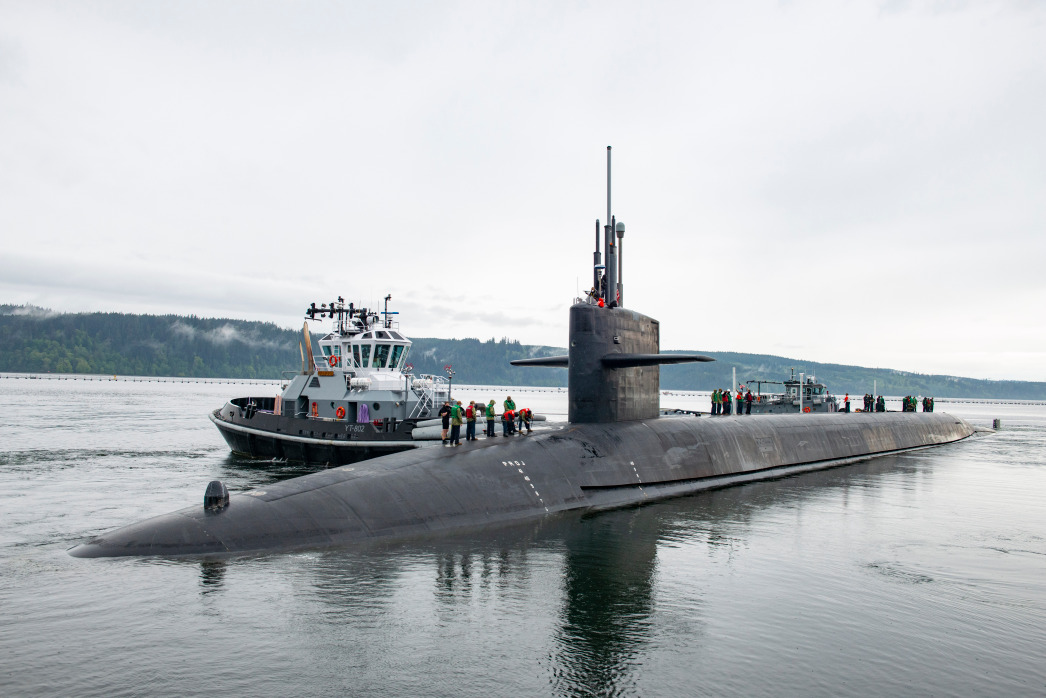
The Trump administration, in a closely held memo to lawmakers this spring, justified developing the first new U.S. atomic weapon since the Cold War by citing vulnerabilities and risks in the current nuclear arsenal that are rarely or never acknowledged in public.
In an unclassified five-page white paper sent to Congress in May, the Pentagon and the Energy Department’s National Nuclear Security Administration, or NNSA, affirm a point they have long minimized: the dangers of land-based missiles ready to launch minutes after a warning of enemy attack.
They also discuss threats to U.S. nuclear missile submarines that have previously been depicted as all but undetectable. They say, too, that a new class of ballistic missile submarines lacks the firepower of its predecessors, creating a need for a lighter and more powerful type of warhead — in addition to the two existing types. As for the current two sets of warheads, they say they have too few of the most destructive kind and too many of the less forceful variety — and excessively rely on the latter.
Gov. argues against Holtec nuclear storage site
Gov. Michelle Lujan Grisham sent a letter to President Donald Trump on Tuesday, arguing against a proposed nuclear waste interim storage facility in southeast New Mexico.
“The proposed (facility) would join the ranks of uranium mining, nuclear energy and defense-related programs that have long created risks to public health and the environment in the state of New Mexico that are disproportionately greater than such risks to the general population of the United States,” she wrote.
BY: THERESA DAVIS, JOURNAL STAFF WRITER | Copyright © 2020 Albuquerque Journal
The proposed Holtec International site would store 500 stainless steel canisters of the nation’s spent nuclear fuel on 1,000 acres between Carlsbad and Hobbs, with a full storage capacity of 10,000 canisters.
“New Mexico has grave concerns for the unnecessary risk to our citizens and our communities, our first responders, our environment, and to New Mexico’s agriculture and natural resource industries,” Lujan Grisham wrote in the letter.
LANL trolley that carries radioactive material broken down
“If LANL can’t drive a trolley or clean up old stuff without exposing people, how can they safely expand plutonium pit production?” asked Scott Kovac, research and operations director for nonprofit Nuclear Watch New Mexico.
BY: SCOTT WYLAND | santafenewmexican.com
An internal trolley that carries radioactive material to several glove-box areas at Los Alamos National Laboratory’s plutonium facility has been broken for almost two months, hindering operations at the site, a federal watchdog report said.
The trolley became disabled in early June, and its bucket is stuck with a container of nuclear material inside, according to a report issued by the Defense Nuclear Facilities Safety Board.
“However, the location is not creating any radiological exposure concerns,” the report said.
The report noted the idled trolley has hampered the internal transfer of radioactive material to the sealed containers with protective gloves attached, but it didn’t say to what extent.
“F-35s Don’t Help Families Pay Their Bills”: GOP Slips Pentagon Into COVID Bill
“People are dying, or worried about keeping a roof over their families’ heads, or cutting hours because their kids’ schools are closed,” said Anthony Weir, a lobbyist on nuclear disarmament and Pentagon spending at the Friends Committee on National Legislation. “And this is the time to jam some military procurement into this year that you didn’t get last year?”
BY: JAKE JOHNSON | truthout.org

SAMUEL KING JR. / U.S. AIR FORCE
In a floor speech late Monday, Senate Majority Leader Mitch McConnell described the GOP’s newly released coronavirus stimulus package as a “carefully tailored” plan to provide financial relief to desperate Americans.
But a look at the legislative text (pdf) released by Senate Republicans shows the HEALS Act is replete with massive gifts to the Pentagon and defense contractors that would do nothing to aid the unemployed, provide nutrition assistance to hungry children, prevent an avalanche of evictions, or stop the spread of coronavirus.
“Last time I checked F-35s don’t help families pay their bills,” Rep. Chuy García (D-Ill.) tweeted in response to the GOP’s proposal of $686 million in spending on new fighter jets.
Pending Energy Spending Bill Mixed Bag for INL
“We all know major change takes time, and we know that it is difficult to turn this ship, but we are doing it in our time…We can and must do better than refight a tired old battle on Yucca Mountain.” – Rep. Marcy Kaptur, D-Ohio
By: NATHAN BROWN | postregister.com
Idaho National LaboratoryThe Energy and Water appropriations bill Congress is expected to take up next week represents a mixed bag for Idaho National Laboratory, with spending on some priorities kept flat and slight increases for others.
The U.S. House Appropriations Committee voted along party lines earlier this month, with the Democrats in favor and the Republicans opposed, to advance the bill. At $49.6 billion in the regular budget, it represents a $1.26 billion increase over this year’s spending, according to a committee reporting summarizing the bill. However, on top of this it also includes an additional $23.5 billion in emergency one-time funding meant to bolster various clean energy projects and aid in recovery from the coronavirus pandemic that has led to pushback from Republicans. It and six other spending bills are expected to be considered by the full House this week, according to a news release from the committee.
Rep. Tulsi Gabbard Rebuts U.S. Claim that Marshall Islands Nuclear Waste Site is Safe
“The U.S. government is responsible for this storage site and must ensure the protection of the people and our environment from the toxic waste stored there,” Gabbard said in a news release announcing her amendment to the defense bill.
BY: SUSANNE RUST | latimes.com
Graffiti in May 2018 is written on Runit Dome, in Enewetak Atoll of the Marshall Islands, urging the United States to take responsibility for the radioactive waste encapsulated inside the concrete structure. The U.S. government paid a contractor to remove the graffiti from the dome’s surface. (Mika Makelainen / Yle)One of Hawaii’s high-profile politicians has dismissed a recent Department of Energy report concluding that a leaking U.S. nuclear waste repository in the Marshall Islands is safe for people there.
She called for the department to convene a more independent assessment of the waste site.
“I think it’s time the Department of Energy relied on someone with fresh eyes to examine the situation,” said U.S. Rep. Tulsi Gabbard, one of Hawaii’s two Democratic House members, in a recent interview with The Times.
Gabbard, who gained national attention by launching what some called a quixotic campaign for the Democratic presidential nomination, has been outspoken in Congress on behalf of the Marshall Islands, which the United States used as a testing site for scores of nuclear weapons during the Cold War.
She’s pushed to reinstate Medicaid eligibility to people from the Marshall Islands, Micronesia and Palau who are working and living in the United States but lack access to healthcare. She also was instrumental in requiring the Department of Energy to reexamine the safety of Runit Dome, a leaking nuclear waste repository in the Marshall Islands, as part of the 2019 National Defense Authorization Act.
Novel gas-capture approach advances nuclear fuel management
“If one day we want to treat the spent fuels, which in the U.S. are currently stored in pools and dry casks at the nuclear power plant sites, we need to handle the volatile radionuclides.” explains Ju Li, MIT’s Battelle Energy Alliance Professor of Nuclear Science and Engineering and professor of materials science and engineering. “Physisorption of krypton and xenon is a good approach, and we were very happy to collaborate with this large team on the MOF approach.”
By: PETER DUNN, MIT | phys.org
Separation of 85Kr from spent nuclear fuel by a highly selective metal organic framework. Credit: Mike Gipple/NETLNuclear energy provides about 20 percent of the U.S. electricity supply, and over half of its carbon-free generating capacity.
Operations of commercial nuclear reactors produce small quantities of spent fuel, which in some countries is reprocessed to extract materials that can be recycled as fuel in other reactors. Key to the improvement of the economics of this fuel cycle is the capture of gaseous radioactive products of fission such as 85krypton.
Therefore, developing efficient technology to capture and secure 85krypton from the mix of effluent gasses would represent a significant improvement in the management of used nuclear fuels. One promising avenue is the adsorption of gasses into an advanced type of soft crystalline material, metal organic frameworks (MOFs), which have extremely high porosity and enormous internal surface area and can incorporate a vast array of organic and inorganic components.
Top Ex-SCANA Official Stephen Byrne Pleads Guilty in SC Nuclear Fiasco Fraud Case
Stephen Byrne, a top executive of the now-defunct SCANA electric utility, pleaded guilty Thursday to criminal conspiracy fraud charges in federal court in Columbia.
BY: John Monk & Joseph Bustos | thestate.com
Byrne was part of a conspiracy that engineered a “cover-up” to hide the extent of the publicly traded company’s financial problems caused by the nuclear project’s difficulties, according to charging documents in his case. “Through intentional misrepresentations,” Byrne and others deceived regulators and customers, documents said.
White House held talks over resuming US nuclear tests, John Bolton says
Ex-Trump adviser and testing advocate tells Guardian ‘certainly it was discussed’ but no decision was made by the time he left
BY: JULIAN BORGER | theguardian.com
John Bolton acknowledged that there was resistance to testing from other officials in the Trump administration. ‘I think different people have different views,’ he said.White House officials held a series of discussions over the past two years on the possibility of resuming US nuclear testing, according to the former national security adviser John Bolton.
“Certainly the subject was discussed,” Bolton, a fierce advocate of testing, told the Guardian. However, there was opposition from some in the administration who felt current computer-based testing of US warheads was sufficient, and no decision was made by the time Bolton left the White House last September.
When the prospect of the first US underground nuclear test in nearly three decades came up at a White House meeting in May, it triggered an outcry from arms control advocates and a Democratic amendment to the 2021 National Defense Authorization Act, blocking funding for preparations for a test.
Bolton, who has published a memoir on his time in the Trump White House titled The Room Where It Happened, said the issue was discussed in general terms on a number of occasions while he was national security adviser from April 2018 to September 2019. However, the discussions did not become “operational” as his priority had been to take the US out of the Intermediate-range Nuclear Forces (INF) treaty.
Ohio Nuclear Power Scandal
As [David] DeVillers described it at a press conference: it was the “largest bribery, money laundering scheme ever perpetrated against the people of Ohio.”
BY: KARL GROSSMAN | counterpunch.org
Photograph Source: David_Besse_NPP.jpg: Nuclear Regulatory Commission. Original uploader was Theanphibian at en.wikipedia – Public Domain
The U.S. Attorney’s Office and FBI this week charged the speaker of the Ohio House of Representative and four others in a $61 million scheme to use $1 billion in ratepayers money to keep two decrepit nuclear power plants operating.
And, said the U.S. Attorney for the Southern District of Ohio, David DeVillers, at a press conference after the arrests Tuesday: “This is by no means over. We are going to continue with this investigation.”
Those charged were involved in a “Conspiracy to Participate, Directly or Indirectly” in the scheme “through a Pattern of Racketeering Activity,” declared the “Offense Description” that headed an 81-page federal “Criminal Complaint.”
A Dirty Battle for a Nuclear Bailout in Ohio
“It has been known since the late 1970s that the cost of constructing nuclear plants in the United States is very high, but the cost gap between nuclear electricity and other alternatives has increased dramatically in the last decade. In its most recent estimate, the Wall Street firm Lazard estimated that a new nuclear plant will generate electricity at an average cost of $155 per megawatt hour, nearly four times the corresponding estimates of around $40 per megawatt hour each for new wind and solar energy plants. The average cost for natural gas plants is $56 per megawatt hour.
The gap will only grow larger. While the costs of nuclear power have been increasing, the costs of wind and solar power have declined by around 70 to 90 percent in the last decade.”
BY: Shakiba Fadaie & M. V. Ramana | thebulletin.org
mailer sent to thousands of Ohio residents falsely linked the Chinese government to anti-bailout activists. Image credit: WTOL Toledo, via Twitter.Last July, Ohio’s governor signed House Bill 6 (HB6) to provide FirstEnergy (now Energy Harbor), a large electric utility, with subsidies of nearly $150 million per year to keep its Perry and Davis-Besse nuclear power plants operating. Ohio is only the fifth US state to offer such subsidies; other states include New York, Illinois, New Jersey, and Connecticut. Although the subsidies are justified by some as necessary for climate mitigation, in the latter four states, electricity generation from natural gas, which results in greenhouse gas emissions, has increased since 2017, when these subsidy programs started kicking in. Moreover, in Ohio, subsidies are also being extended to coal power plants, providing the clearest illustration that what underlies the push for subsidies to nuclear plants is not a result of a real commitment to climate mitigation but a way to use climate concerns to bolster the profits of some energy corporations.
Video: Obstacles to Nuclear Abolition — a discussion with David Swanson, Alice Slater, and Bruce Gagnon
David Swanson, Alice Slater, and Bruce Gagnon discuss obstacles to nuclear abolition and the U.S.-Russia relationship.
Inhofe, Reed Praise Senate Passage of National Defense Authorization Act for Fiscal Year 2021
The United States Senate today passed the National Defense Authorization Act for Fiscal Year 2021, 86-14.
Thursday, July 23, 2020 PRESS RELEASE: https://www.armed-services.senate.gov/press-releases/inhofe-reed-praise-senate-passage-of-national-defense-authorization-act-of-fiscal-year-2021
- Full text of Bill: https://www.congress.gov/116/bills/s4049/BILLS-116s4049rs.pdf
- Report to go with Senate NDAA, which passed the full Senate on July 23: https://www.congress.gov/116/crpt/srpt236/CRPT-116srpt236.pdf
Responsibility for Los Alamos Plutonium Facility 4 and Technical Area 55
Plutonium Facility 4 (PF–4) at Los Alamos National Laboratory’s Technical Area 55 is the primary plutonium handling facility within the National Nuclear Security Administration (NNSA). PF–4 is currently undergoing major modifications to produce war reserve plutonium pits, with a production goal of 30 pits per year by 2026.Continue reading
Bribed Ohio’s $60 Million Radioactive Uproar Rocks the 2020 Vote
“Ohio is in election-year turmoil over a Trump-supported nuke bailout bought with bribery. Whether public fury will kill the handout and affect the fall presidential election remains to be seen…But Bribed Ohio 2020 has clearly gone radioactive.”
BY: Bob Fitrakis & Harvey Wasserman | readersupportednews.com
Ohio’s biggest-ever bribery case is rocking America’s reactor industry … and the fall election.
Full details of the shocking arrest of Ohio’s powerful Speaker of the House are still unfolding.
But on Monday, the FBI charged Larry Householder and four associates with taking $60 million (that’s NOT a typo) in bribes from “Company A,” suspected to be the Akron-based nuke utility FirstEnergy. The company has not been formally named as the source of the bribe, but FE’s stock has since plummetted.
Trinity: 75 Years Later
On the 75th anniversary of the world’s first nuclear weapons explosion: The Trinity test near Alamogordo in 1945, KSFR News Director Tom Trowbridge spoke with a longtime New Mexico journalist about the anniversary.
Former SCANA Executive Pleads Guilty to Fraud Charges Tied to Failed SC Nuclear Project
“I’m glad there is going to be a little bit of justice and that Mr. Byrne is now pleading guilty to his crime, so it’s a matter of holding others accountable who were former executives of SCANA,” Tom Clements said. “I would anticipate that Kevin Marsh and Jimmy Addison are probably next in the queue to be charged, and hopefully others.”
BY: Andrew Brown & Avery G. Wilks | postandcourier.com
Covid-19 Stopped Water Pollution Monitoring At A Major Radioactive Site For Months
“Given LANL’s history it’s imperative that monitoring be robustly resumed,” Jay Coghlan, Executive Director of Nuclear Watch New Mexico, said in an email. “This is after all the Lab that use to claim that groundwater contamination was impossible… Now we know of heavy chromium and high explosives groundwater contamination which are a harbinger for more contaminants to come.”
BY: ERIC MACK | forbes.com
Town of Los Alamos, New Mexico on the left and center, the Omega Bridge in the middle and the Los Alamos National Laboratories on the right. GETTYWhen the coronavirus and resulting Covid-19 pandemic closed everything in mid-March, TA-54 was one of the many places where all activity came to a virtual standstill.
Technical Area 54 is a part of Los Alamos National Labs (LANL) in New Mexico – the same Los Alamos that was home to the Manhattan Project, which ushered in the atomic era and today continues to produce radioactive triggers for nuclear weapons.
Within TA-54 is what’s called Area G. The federal government refers to as LANL’s “legacy waste management area.” For over 60 years, it has been a storage, processing and disposal area for different kinds of radioactive and otherwise toxic waste from LANL.
Nuclear Tests Have Changed, but They Never Really Stopped
75 years after the first explosive nuclear tests, now outlawed, sophisticated virtual testing allows American physicists to understand these weapons better than ever.
BY: DANIEL OBERHAUS | wired.com
PHOTOGRAPH: GALERIE BILDERWELT/GETTY IMAGESJUST BEFORE SUNRISE on July 16, 1945—75 years ago today—a patch of New Mexican desert was incinerated during the first trial of the most destructive weapon ever created. The plutonium bomb used for the Trinity test left a 5-foot crater in the ground and turned the surrounding desert floor into a radioactive green glass. The blast bathed the peaks of the nearby Oscura Mountains in a blinding white light, and dozens of scientific observers watching from 20 miles away reported feeling an immense heat wash over them. As the light from the explosion faded, one of the architects of the bomb, Kenneth Bainbridge, gave a pithy appraisal of the event to J. Robert Oppenheimer, the project’s lead scientist: “Now we are all sons of bitches.”
And he was right. Less than a month later, the United States dropped the same type of bomb on Nagasaki, Japan, just three days after detonating a smaller nuclear warhead over Hiroshima. It effectively ended World War II, but it came at the price of well over 100,000 civilian lives and the enduring suffering of those who survived.
DOE Targets End to US Reliance on Russian Nuclear Fuel, Revived Domestic Capability
“Industry and NGO representatives did not agree with Brouillette’s assertions regarding U.S. reliance on Russian nuclear fuel.
“Brouillette overstated the U.S. commercial nuclear industry’s dependence of Russian uranium ore, Edwin Lyman, director of nuclear power safety at the Union of Concerned Scientists, told Utility Dive. “Most of it comes from Australia and Canada,” he said. Industry sources put the amount coming from Russia at 20%.”
By: JOHN FUNK | utilitydive.com
Dive Brief:
- The Department of Energy is working to end U.S. reliance on Russia for nuclear fuel, Secretary Dan Brouillette told members of the House Energy and Commerce Subcommittee on Energy last week.
- The department’s Nuclear Fuel Working Group wants American-sourced uranium and plans to begin processing U.S. uranium into high-grade fuel at a DOE facility in Portsmouth, Ohio, as early as next year, Brouillette said. The high-grade fuel is particularly important for new and smaller commercial reactors that DOE considers critical to grid stability as renewables replace aging fossil fuel power plants, he said.
- Brouillette also said the government has been able to blunt cyber attacks on the U.S. power grid “from places like Russia” and is working to ban Chinese-made grid equipment it believes could contain spyware, he told the subcommittee.
Global Zero Mourns the Loss of Dr. Bruce Blair
June 20, 2020
Source: Global Zero
“We are saddened to announce that Dr. Bruce G. Blair, Co-Founder of Global Zero and President of its Board of Directors, died unexpectedly on Sunday, July 19, following a sudden illness.
Derek Johnson, Executive Director of Global Zero, released the following statement on behalf of the organization regarding the recent passing of Dr. Blair:
“I am heartbroken at the sudden loss of my colleague, mentor, and dear friend, Bruce Blair.
“15 years ago, Bruce brought together an unprecedented international community of leaders and visionaries to build a new kind of movement to persuade governments to come to their senses and set aside the most catastrophic weapons on the planet. A veteran nuclear launch officer and unrivaled expert in command and control, Bruce understood — perhaps better than any single person alive — the urgency, enormity, and complexity of the nuclear threat. He built the Global Zero movement from the ground up and devoted all of his energy to making the world safer and better for all people.
DOE Responds To NMED Concerns About Lack Of Plan For Contaminated Materials Unearthed At Middle DP Road Since February
BY: MAIRE O’NEILL | losalamosreporter.com

The Department of Energy Office of Environmental Management Los Alamos and the National Nuclear Security Administration Los Alamos Field Office have responded to New Mexico Environment Department concerns about the DOE’s failure to address their plans for mitigation of contamination at Middle DP Road. Since February, there have been at least three discoveries of radioactive material in the vicinity of two housing projects underway on property that was turned over to Los Alamos County by NNSA for public use.
NMED has complained that DOE has failed to provide a schedule of preliminary screening plan (PSP) activities that indicates that DOE “understands the seriousness of this matter” and has not provided a timeframe for implementation of the plan. NMED has asked DOE for the basis of the delay in implementing the PSP “to ensure full transparency and understanding of why this important risk to public health is not being addressed in a more timely manner”.
Trinity’s Atomic Blast Changed the World
As the first atomic blast lit up the morning sky and scorched a vast desert landscape in south-central New Mexico, the scientists and engineers who had worked on this top-secret weapon felt a mixture of relief, awe and trepidation.
BY: SCOTT WYLAND | santafenewmexican.com
Trinity: “The most significant hazard of the entire Manhattan Project”
“New Mexico residents were neither warned before the 1945 Trinity blast, informed of health hazards afterward, nor evacuated before, during, or after the test. Exposure rates in public areas from the world’s first nuclear explosion were measured at levels 10,000- times higher than currently allowed.”
BY: KATHLEEN M. TUCKER & ROBERT ALVAREZ | thebulletin.org
For the past several years, the controversy over radioactive fallout from the world’s first atomic bomb explosion in Alamogordo, New Mexico on July 16, 1945—code-named Trinity—has intensified. Evidence collected by the New Mexico health department but ignored for some 70 years shows an unusually high rate of infant mortality in New Mexico counties downwind from the explosion and raises a serious question whether or not the first victims of the first atomic explosion might have been American children. Even though the first scientifically credible warnings about the hazards of radioactive fallout from a nuclear explosion had been made by 1940, historical records indicate a fallout team was not established until less than a month before the Trinity test, a hasty effort motivated primarily by concern over legal liability.
In October 1947, a local health care provider raised an alarm about infant deaths downwind of the Trinity test, bringing it to the attention of radiation safety experts working for the US nuclear weapons program. Their response misrepresented New Mexico’s then-unpublished data on health effects. Federal and New Mexico data indicate that between 1940 and 1960, infant death rates in the area downwind of the test site steadily declined—except for 1945, when the rate sharply increased, especially in the three months following the Trinity blast. The 21 kiloton explosion occurred on a tower 100 feet from the ground and has been likened to a “dirty bomb” that cast large amounts of heavily contaminated soil and debris—containing 80 percent of the bomb’s plutonium—over thousands of square-miles. (See Figure 1.)
‘Now I Am Become Death’: The Legacy of the First Nuclear Bomb Test
“Since the Trinity test 75 years ago, at least eight countries have conducted more than 2,000 nuclear bomb tests, said Jenifer Mackby, a senior fellow at the Federation of American Scientists. More than half of those tests have been conducted by the United States, a legacy of the Trinity explosion, as the United States and several other countries have continued to refuse to ratify the treaty prohibiting nuclear weapon test explosions.”
BY: MARIA CRAMER | nytimes.com
An aerial view of the aftermath of the first atomic explosion at the Trinity test site in New Mexico in 1945. The device exploded with a power equivalent to 21,000 tons of TNT. Credit Associated PressIt was 1 a.m. on July 16, 1945, when J. Robert Oppenheimer met with an Army lieutenant general, Leslie Groves, in the parched landscape of Jornada del Muerto — Dead Man’s Journey — a remote desert in New Mexico.
A group of engineers and physicists was about to detonate an atomic device packed with 13 pounds of plutonium, a nuclear weapon that the government hoped would bring an end to World War II.
Some scientists on the project worried that they were about to light the entire world on fire, according to researchers. Others worried that the test would be “a complete dud.”
Mr. Oppenheimer, who was tasked with designing an atomic bomb for the Manhattan Project, had not slept.
At 5:29 a.m. local time, the device exploded with a power equivalent to 21,000 tons of TNT and set off a flash of light that would have been visible from Mars, researchers said.
It was the first nuclear test in history.
Less than a month later, the United States would drop a nearly identical weapon on the city of Nagasaki in Japan.
In their own words: Trinity at 75
On July 16, 1945 the first nuclear bomb exploded near Alamogordo, New Mexico. The Trinity test marked the culmination of nearly four years of secret research led by an unprecedented collaboration of the world’s top scientists and the US military. It also guaranteed that the uranium gun-type weapon dropped on Hiroshima could be followed by another that used the plutonium implosion design tested at the Trinity Site. In essence, Trinity was a test-of-concept for the bomb that leveled Nagasaki.
The history of the Manhattan Project and the birth of the bomb have been examined and reexamined countless times over the past seven decades—as have the threats they posed to humanity.Though nearly all now are dead, many scientists, soldiers, and family members who attended the birth of the bomb documented their first-hand experiences in the pages of the Bulletin in a way that lives on, providing an exceptional and vivid glimpse of their struggles to achieve victory in war and science.
Read together, the eyewitness excerpts below offer a new retelling of the Trinity test, woven entirely from words that more than a dozen of the project’s protagonists first published in the Bulletin.
SUITABLE GROUND: ALAMOGORDO
Lt. Gen. Leslie R. Groves
Groves was the Army administrative officer in charge of the entire wartime Manhattan Project. Scientists at Los Alamos loathed his policy of “compartmentalization,” which aimed to isolate scientists to preserve secrecy.
In the early days, we believed that a gun-type bomb would be entirely satisfactory for both uranium-235 and for plutonium, and we did not feel that any full-scale test would be necessary. Later, when we learned that the gun-type would not be suitable for plutonium, we began to realize that we might find it advisable to test the implosion-type bomb. … As soon as a full-scale test—and it had to be full-scale—became likely, we began the search for a suitable testing ground.
Church Rock Uranium Spill July 16, 1979
In 1968, the United Nuclear Corporation initiated mining operations in the largest underground uranium mine in the United States. Located in Church Rock, New Mexico, in the Navajo Native American Reservation, the Church Rock Mill produced more than two million pounds of uranium oxide per year. Waste from the mining process was disposed of in three lined lagoons fortified by a man-made dam built on geologically unsound land—of which both the United Nuclear Corporation and state and federal agencies were aware. On 16 July, 1979, the dam breached and 1100 tons of uranium waste and 94 million gallons of radioactive water seeped into the Puerco River. Scientists estimate that the amount of radiation released in the Church Rock uranium mill spill was larger than the amount released at Three Mile Island, just four months prior. Surrounding residents of the mill, almost entirely Navajos, relied on the Puerco River as a watering source for livestock. They have since suffered severe health problems due to substantial increases in radioactivity found in the water, soil, and air. Despite several selective investigations and cleanup efforts by the US Environmental Protection Agency, ramifications of the spill remain evident in the Navajo Nation today.
From environmentandsociety.org
Interview with Larry King, who worked on-site at the United Nuclear Corporation mine the day of the tailings pond spill, and still lives in the area.
Church Rock SPECIAL Encore presentation on the 1979 #Radioactive #Uranium tailings pond spill in #NavajoNation that spread #Radiation thru 80 miles of the Puerco River & still hasn't been cleaned up. Interviews w/elders, activists, politicians. https://t.co/xvIcjd5jGu pic.twitter.com/MLQwY9BP2V
— Libbe HaLevy (@NuclearHotseat) July 14, 2020
Nuclear Hotseat Podcast episode on the Church Rock Spill
Escalation by Tweet: Managing the new nuclear diplomacy
Can a tweet start a nuclear war? New Report examines impact of Twitter on crisis escalation and recommends a “no tweeting policy” during crises.
[embeddoc url=”https://www.kcl.ac.uk/csss/assets/10957•twitterconflictreport-15july.pdf” download=”all” viewer=”google”]
Atomic Anniversary Brings U.S. Nuclear Official to New Mexico
“Los Alamos is facing of a 2026 deadline to begin producing at least 30 of the plutonium cores a year — a mission that has the support of the most senior Democratic members of New Mexico’s congressional delegation as the work is expected to bring jobs and billions of federal dollars to update buildings or construct new factories. The effort has drawn much criticism from watchdog groups that long have been concerned about the lab’s safety record, missed deadlines, repeated cost overruns and the pace of cleaning up contamination resulting from decades of bomb making and nuclear research.”
BY: SUSAN MONTOYA BRIAN | apnews.com
ALBUQUERQUE — The head of the National Nuclear Security Administration is in New Mexico this week as part of a nationwide tour of the federal government’s nuclear security operations.
The visit by Administrator Lisa Gordon-Hagerty coincides with the 75th anniversary of the Trinity test in Southern New Mexico, which marked the world’s first atomic blast on July 16, 1945. She’s scheduled to lead a commemoration Thursday at the historic V-Site at Los Alamos National Laboratory, where early testing and some assembly of the atomic bomb took place.
Gordon-Hagerty has been spearheading the federal government’s recent efforts to resume and ramp up production of the plutonium cores that are used to trigger nuclear weapons. The work will be split between Los Alamos and the Savannah River Site in South Carolina.
Trinity Downwinders: 75 Years and Waiting
Tularosa Basin Downwinders Consortium (TBDC)
REMEMBERING THE 75TH ANNIVERSARY OF THE TRINITY TEST
*** I M M E D I A T E P R E S S R E L E A S E ***
Thursday, July 16, 2020
Virtual Event at 9:00 a.m. MDT
Access at www.trinitydownwinders.com
Trinity Downwinders are commemorating the 75th Anniversary since the first nuclear test was conducted anywhere in the world and bringing attention to the fact that New Mexicans still have not received Radiation Exposure Compensation Act (RECA) benefits.

RECA was passed in 1990 by the US Government to provide health care coverage and compensation to downwinders from other parts of the country but has never included the people of New Mexico. The fund has paid out over 2.3 Billion Dollars in reparations to downwinders of the Nevada Test site but never to New Mexico downwinders. It also provides the best health care coverage available.
Trinity Downwinders will commemorate the New Mexicans who have died from cancer and other radiation exposure related diseases during this event and read firsthand accounts of the bomb blast.
Funding Nuclear Weapons at a Time of National Crisis
Nuclear weapons represent the greatest imminent existential threat to our very existence and to every social, racial, environmental and economic justice movement that we are working for, since ultimately it is all connected.
BY: ROBERT DODGE | cpmmondreams.com
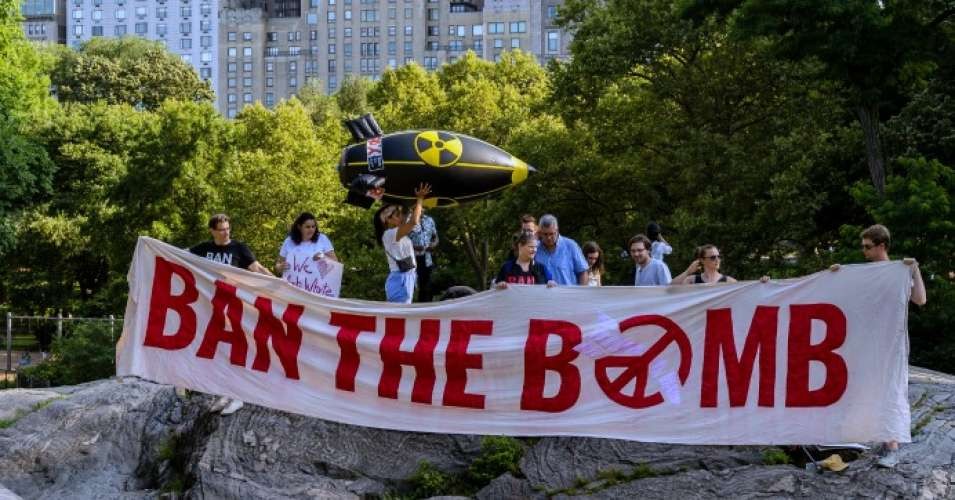
Today, July 15, we fund our nation’s priorities. This year, the nation is awakening to the problems of systemic and institutionalized racism while simultaneously grappling with the ongoing COVID-19 pandemic which has no end in sight. The Black Lives Matter movement is receiving its due attention and communities are demanding demilitarization of police forces and tactics and reprioritization of funding to address the needs of communities to bring forth a socially just, environmentally sustainable and peaceful community. City councils are taking a close look at police budgets and many citizens are calling for participatory budgeting with input in the budgets of their cities as they move to determine their own priorities. Nationally, with our massively bloated defense budget, it is also the time we fund the nuclear arms race even as nations around the world work to pass a nuclear ban treaty, the “Treaty on the Prohibition of Nuclear Weapons”, similar to those banning all other weapons of mass destruction.
15 LANL Workers Tested for Radiation Exposure After Mishap
“Mishandled glove boxes are a long-standing problem at the lab, but having 15 workers possibly exposed to radiation because of one breach is a high number and could become more common as the plutonium plant ramps up production of nuclear cores.” — Scott Kovac, research and operations director for nonprofit Nuclear Watch New Mexico.
“The 15 workers is just an example of things to come,” Kovac said.
“The 15 workers is just an example of things to come,” Kovac said.
BY: SCOTT WYLAND | santafenewmexican.com
publicintegrity.org
Fifteen employees at Los Alamos National Laboratory’s plutonium plant were tested for radiation exposure after a “glove box” breach in June contaminated the work area.
Air monitors sounded an alarm at the facility when an operator accidentally ripped off the protective gloves attached to a sealed compartment for handling plutonium after the worker weighed and packaged plutonium-238 oxide powder.
The breach contaminated the worker’s protective clothing, hair and skin, and caused enough potential airborne exposure that other workers had to be tested for radiation, according to a report by the Defense Nuclear Facilities Safety Board.
Trump Plan to Build Nuclear Bombs Divides a Scarred Factory Town
“To me, they haven’t proven that this is going to be safe,” said Pete LaBerge, a 70-year-old retiree who lives about three miles away from the Savannah River Site in nearby Windsor, which has 150 residents. He worries about a release of radiation. “Part of my theory is it’s sort of a make-work program for the Energy Department.”
BY: ARI NATTER & CHARLIE MCGEE | bloomberg.com
A factory along South Carolina’s Savannah River produced tritium and plutonium for U.S. nuclear weapons during the Cold War, employing thousands of workers but leaving behind a toxic legacy of radioactive waste.
Now the Trump administration has proposed spending $9 billion over 10 years to restart production of bomb parts there and at another site. The plan has raised the welcome prospect of new jobs though also rekindled environmental fears. And it’s set off alarms about a new nuclear arms race just as key treaties with Russia lapse.
ABC NEWS FILE PHOTO Nov., 20, 2013, file photo, radioactive waste, sealed in large stainless steel canisters, are stored under a five-feet of concrete in a storage building at the Savannah River Site near Aiken, S.C.“It’s a waste of money and dangerous,” said Stephen Young, an expert on arms control and international security issues for the Union of Concerned Scientists.
President Donald Trump’s plan, announced by the departments of Energy and Defense in 2018, calls for restarting production of nuclear bomb ‘pits’ at the South Carolina site and another one in New Mexico. The bowling-ball sized spheres of plutonium act as the trigger in a nuclear warhead, setting off the explosive chain reaction.
WIPP: Nuclear Watchdog Group Again Challenges Utility Shaft in New Mexico Supreme Court
The Southwest Research and Information Center previously filed a motion to the court in April, seeking to block the New Mexico Environment Department’s (NMED) temporary approval (TA) of plans for the shaft that saw no public hearing or comment process.
BY: ADRIAN HEDDEN | carlsbadcurrentargus.com
The $100 million project to build the shaft was intended to increase airflow to the WIPP underground, where transuranic (TRU) waste is permanently disposed of, to allow emplacement of waste and mining of panels where it is emplaced to occur simultaneously.
A nuclear watchdog group in Albuquerque filed two appeals in New Mexico Supreme Court last week, seeking to block the construction of a utility shaft at the Waste Isolation Pilot Plant.
‘Will to fight together’: Fiji’s has taken another bold step in the battle against nuclear weapons
“For many in the Pacific, memories of the impact of nuclear weapons testing still exist, its legacies continue, and the Pacific-wide solidarity that started in Fiji carries lessons for the world.”
Ratification of United Nations treaty banning atomic weapons honours a half-century of anti-nuclear activism
By: Vanessa Griffen & Talei Luscia Mangioni | theguardian.com
The Against Testing on Mururoa (ATOM) committee protests on the streets of Suva, Fiji, in the 1970s Photograph: The GuardianIn the streets of Suva in the 1970s it was the young who carried the cause. In afros, headbands and bell-bottom jeans they handed out pamphlets and printed newsletters, performed skits and variety shows, gave lectures, and led rallies on the streets of Fiji’s capital.
Crowds heard firebrand speeches from church leaders, trade unionists, university staff and student leaders.
The Atom (Against Testing on Mururoa) committee, formed in Fiji in 1970, was dedicated to educating, creatively but powerfully, the Fijian public of the dangers of radioactive fallout from French testing and colonialism in the Pacific.
China Challenges the U.S. to Reduce Its Nuclear Arsenal to Same Level
BEIJING — If the United States were willing to reduce its nuclear arsenal to China’s level, China would “be happy to” participate in trilateral arms control negotiation with the U.S and Russia, a senior Chinese diplomat said on Wednesday.
REUTERS/NEW YORK TIMES | nytimes.com
The U.S. has repeatedly called for China to join in trilateral negotiations to extend a flagship nuclear arms treaty between the U.S. and Russia that is due to expire in February next year.
Fu Cong, head of arms control department of Chinese foreign ministry, reiterated to reporters in Beijing on Wednesday that China has no interest in joining the trilateral negotiation.
Senate Undoes Proposed Power Shift in Nuclear Arms Budgeting
Moves comes at the behest of the Energy secretary
BY: JOHN M. DONNELLY | rollcall.com
The Senate voted quietly Thursday to undo a proposal in its fiscal 2021 defense authorization bill that would have given the Pentagon extraordinary new power to shape the Energy Department’s future nuclear weapons budgets.
CQ Roll Call reported this week on behind-the-scenes opposition to provisions in the Senate Armed Services Committee’s version of the NDAA that would have given certain Defense Department officials new clout to set the amount and the content of the budget the Energy Department prepares for its National Nuclear Security Administration every year.
Appropriations Committee Releases Fiscal Year 2021 Energy and Water Development Funding Bill
“Policy Provision: The bill prohibits funding for nuclear weapons testing.”
FOR IMMEDIATE RELEASE
July 6, 2020
Contact:
Evan Hollander (Appropriations), 202-225-2771
Griffin Anderson (Kaptur), 202-225-4146
Legislation invests $49.6 billion in Energy and Water Development programs, an increase of $1.26 billion above the fiscal year 2020 enacted level, addressing climate change, improving infrastructure, and upholding our commitment to strengthening national security
In response to the economic recession caused by the coronavirus pandemic, legislation provides an additional $43.5 billion in emergency spending to repair water infrastructure and modernize energy infrastructure
WASHINGTON — The House Appropriations Committee today released the draft fiscal year 2021 Energy and Water Development and Related Agencies funding bill, which will be considered in subcommittee tomorrow. The legislation funds the U.S. Army Corps of Engineers, Department of the Interior programs, the Department of Energy, and other related agencies.
Fifteen LANL Workers Being Evaluated For Possible Exposure To Plutonium-238 Following June 8 Glovebox Glove Breach
Los Alamos National Laboratory is investigating the possible exposure of Laboratory employees to plutonium-238 after a breach in a glovebox glove at the Plutonium Facility on June 8.
BY: MAIRE O’NEILL | losalamosreporter.com
A Lab spokesperson told the Los Alamos Reporter Monday that employees responded promptly and appropriately, and cleared the room in a safe manner.
“Fifteen Laboratory workers are being evaluated for potential exposure. The area inside the Plutonium Facility where this occurred has been secured, pending a review of the events and there is no risk to public health and safety,” the spokesperson said.
A report by Defense Nuclear Facility Safety Board inspectors Jonathan Plaue and David Gutowski dated June 12 noted that on June 8 continuous air monitors sounded when an operator pulled out of the glovebox gloves after weighing and packaging plutonium-238 oxide powder.
“The worker received significant contamination on his protective clothing, hair, and skin, as well as positive nasal swabs indicating a potential intake. Radiation protection personnel successfully decontaminated the individual, and he was provided chelation therapy,” the report states. “The room experienced significant airborne radioactivity and was contaminated. Fourteen additional workers were placed on bioassay. On Thursday (June 11), Triad management conducted a fact-finding to discuss the event, response, and near-term actions. Given the significance of the event, they chartered a team to perform a comprehensive investigation.”
House Panel Would Block Pentagon From Extra Sway Over Nuclear Weapons Budget
The bill would bar funding for the Pentagon-led Nuclear Weapons Council, and would prevent it from assisting with the budget of the National Nuclear Security Administration, a semiautonomous agency under the Energy Department.
BY: JOE GOULD | defensenews.com
Airman 1st Class William Ray removes the screws holding the nose point of a Minuteman III intercontinental ballistic missile to the rest of the reentry system inside a payload transporter at F.E. Warren Air Force Base, Wyo. (Senior Airman Brandon Valle/U.S. Air Force)WASHINGTON ― House appropriators on Tuesday approved a spending bill that would block plans from defense hawks to give the Pentagon a stronger hand in crafting nuclear weapons budgets.
The House Appropriations Committee passed their Energy-Water bill, which contained the provision, by a voice vote. The $49.6 billion spending bill contained $13.7 billion for nuclear weapons accounts ― a $1.2 billion increase over fiscal 2020 that’s still $1.9 billion less than the president’s request.
Lead Republicans voiced opposition to the bill, arguing that Democrats had not consulted with Republicans on pandemic emergency funds in the bill and that Democrats included policy riders the White House will seek to cut. The top Republican on the House Energy and Water Development, and Related Agencies Subcommittee, Rep. Mike Simpson of Idaho, said the bill “still shortchanges funding for the nuclear weapons program.”
“While I acknowledge the increase above last year, we must also acknowledge that the threats we face today are not the same threats we faced in the years immediately following the end of the Cold War,” he said. “We must adequately fund the activities necessary to maintain a safe, reliable and effective stockpile.”
The bill would bar funding for the Pentagon-led Nuclear Weapons Council, and would prevent it from assisting with the budget of the National Nuclear Security Administration, a semiautonomous agency under the Energy Department.
The Senate Armed Services Committee’s version of the annual defense policy bill would allow the council to edit the budget request after the Energy Department crafts it and before the request is submitted to the White House budget office. The move was seen as giving the Pentagon extra sway to boost warhead programs and nuclear weapons laboratories.
Its introduction came after Energy Secretary Dan Brouillette clashed with SASC Chairman Jim Inhofe, R-Okla., who backed a budget request for the larger number than Brouillette sought.
The Energy-Water spending bill contains language ordering no funds “may be used in furtherance of working through the Nuclear Weapons Council to guide, advise, assist, develop, or execute a budget for the National Nuclear Security Administration.”
Separately, the proposed bill would ban the Trump administration’s reported plan to resume nuclear weapons testing. The bill would prohibit funding “to conduct, or prepare to conduct, any explosive nuclear weapons test that produces any yield.”
“Critically, the bill would prevent the Trump administration from using any funds to carry out its dangerous and short-sighted plan to resume nuclear testing,” House Appropriations Committee Chairwoman Nita Lowey, D-N.Y., said in a statement.
The Trump administration was reportedly discussing whether a “rapid test” could aid it in negotiations with Russia and China, as the White House seeks a trilateral nuclear weapons pact.
The defense appropriations bill introduced Tuesday would also bar funding for explosive nuclear weapons tests.
GROUPS ASK TO RESUME PUBLIC MEETINGS ON BOMB PLANT
Kathy Helms
Nuclear News Archives – 2021
Nothing Found
It seems we can’t find what you’re looking for. Perhaps searching can help.

